Utensils for the opium smoker
Auteur:
Don Duco
Original Title:
De attributen van de opiumschuiver
Année de publication:
1997
Éditeur:
Pijpenkabinet Foundation
Description :
A general introduction in the utensils of the opium smoker. Next to the variety of pipes, the different materials and the characteristics of the opium pipe, also other paraphernalia used in the opium ritual are discussed.
"We would have to settle up with the legend of opium visions: Opium creates a twilight state, it makes the mind fall asleep, enraptures the heart and enlightens the mind" (note 1).
Quote by Jean Cocteau
Of all substances one can smoke, opium certainly has the most legendary reputation. From the mid-nineteenth century onwards, the opium kit, the opium taker and the opium addiction generates romantic, alarming and learning articles in newspapers and magazines. The sweet dreams associated with the use of opium appeal to everyone. A wholesome panacea against pains, fears, dangers and above all a stimulating and mind-expanding remedy. In short, a substance that seems to make life easy. But in addition, there are the frightening and intriguing addiction factors. Habituation is addiction and once addicted there never seems to be a way back.
Opium is extracted from the poppy bulb. It is a substance that has been used since ancient times. In powder form or as pills it mainly serves as an analgesic and sedative. In order to smoke, opium is only used from the moment that tobacco smoking becomes known which is at the beginning of the seventeenth century. Initially, the tobacco is softened in an opium infusion, which strengthens the effect of the tobacco. This is called madat. It was not until the end of the eighteenth century that people learned about smoking pure opium.
The habit of opium smoking has since become known across large parts of Asia. Its origins are in India rather than in China, but the concentration of opium smokers is mainly found in China and the southern border countries: Burma, Laos but also Thailand. The border area of these three countries is known as the Golden Triangle, from 1850 the most important area for the cultivation and processing of the poppy. Opium smoking takes place among all layers of the population: both among the poor agricultural workers and among the administrative upper classes. It is mainly the Chinese who have made a true culture of smoking opium. Offering opium on a special occasion becomes a hospitable gesture.
This article is not about the history of opium or use, but focuses on the opium pipes and its related objects. For those who are hunting for antiquities related to the use of opium, there is still a lot to discover. With this remark I do not refer to the simple opium pipes of the working class. These are often made by attaching a hollow bamboo tube to a simple small ceramic bottle (note 2). Functional and inexpensive, but not attesting to an artistic merit. In material terms, the full-grown culture of opium use is best expressed in the pipes and opium paraphernalia of the higher social class. Especially the Chinese objects stand out because of a beautiful synthesis between functionality and aesthetics. It is this opium pipe that I want to discuss here.
The opium pipe
The primal form of the Chinese opium pipe no doubt goes back to the tobacco pipe that was common in the same region. It consists of a wooden or bamboo stem with a ceramic or more generally a metal bowl at one end (Fig. 1ab). On the other side of the stem, the mouthpiece is made in metal as well as in bone, ivory, glass, jade or other type of stone. Other smoking pipes are fully made in metal (Fig. 1cd). Since the syrupy substance of opium is not very suitable for burning in a small, narrow bowl, the opium pipe is quickly adapted into an new shape.
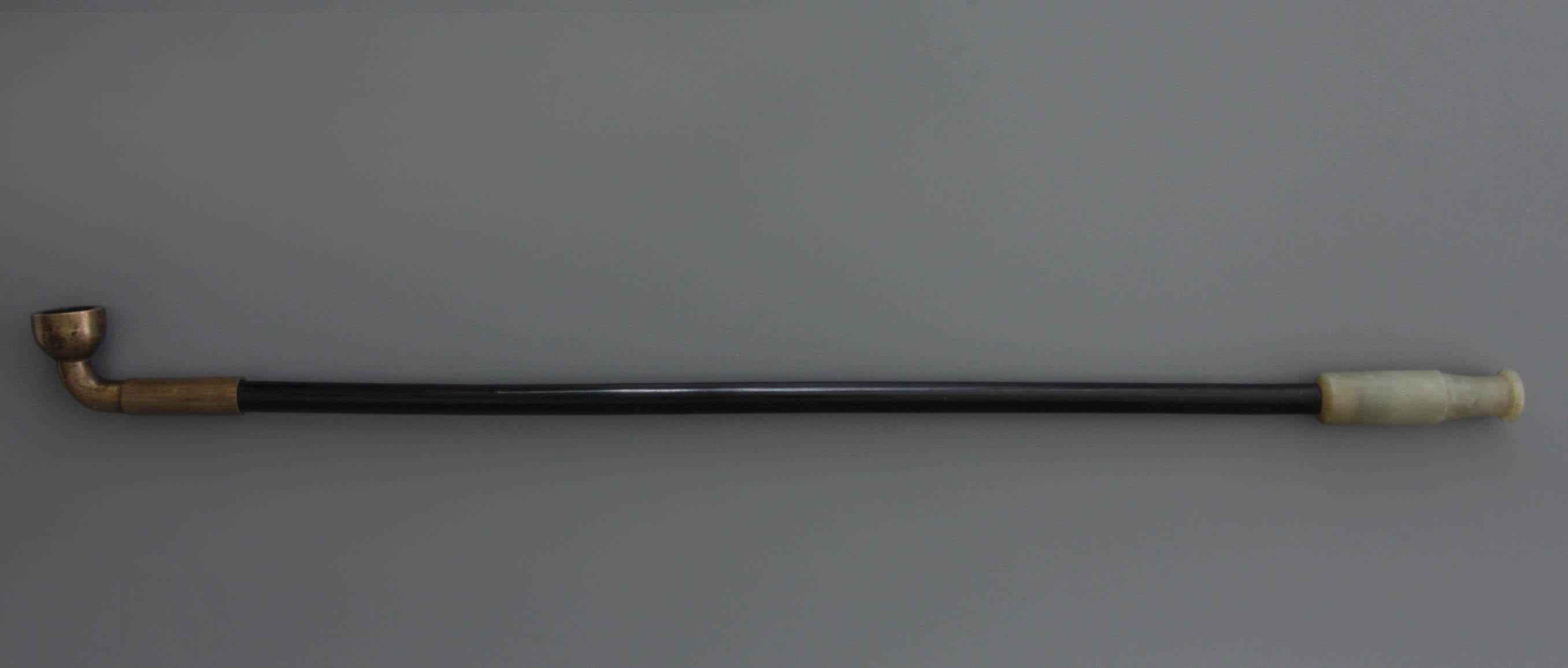
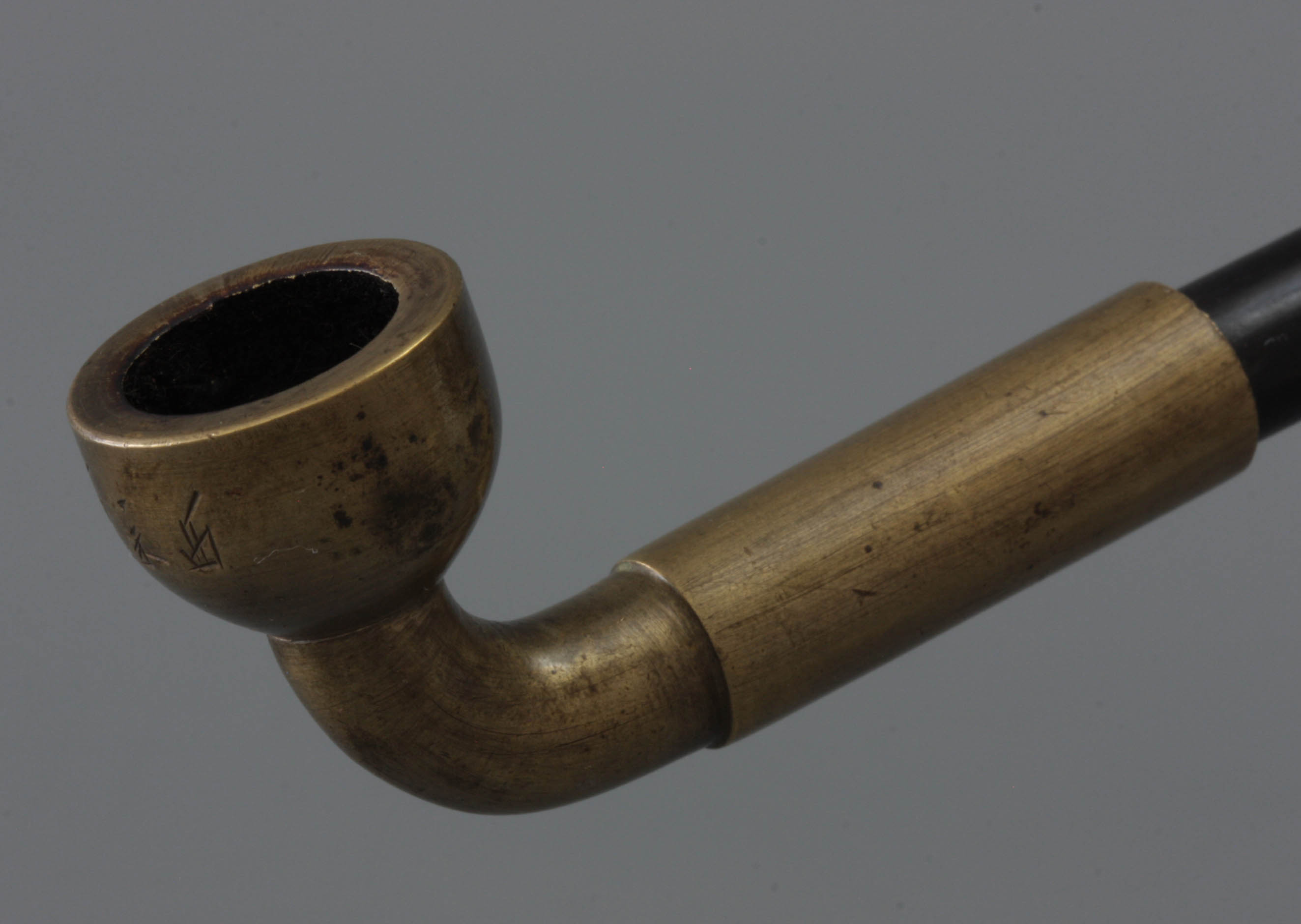
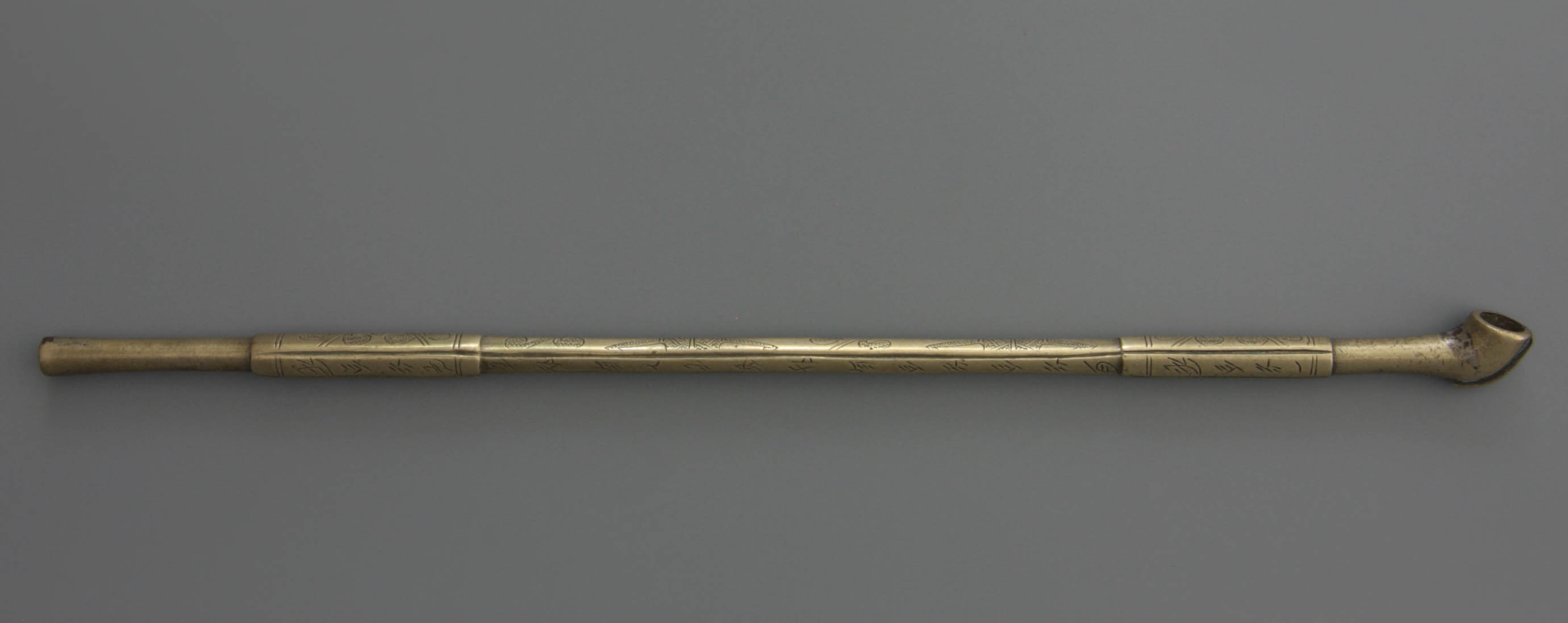
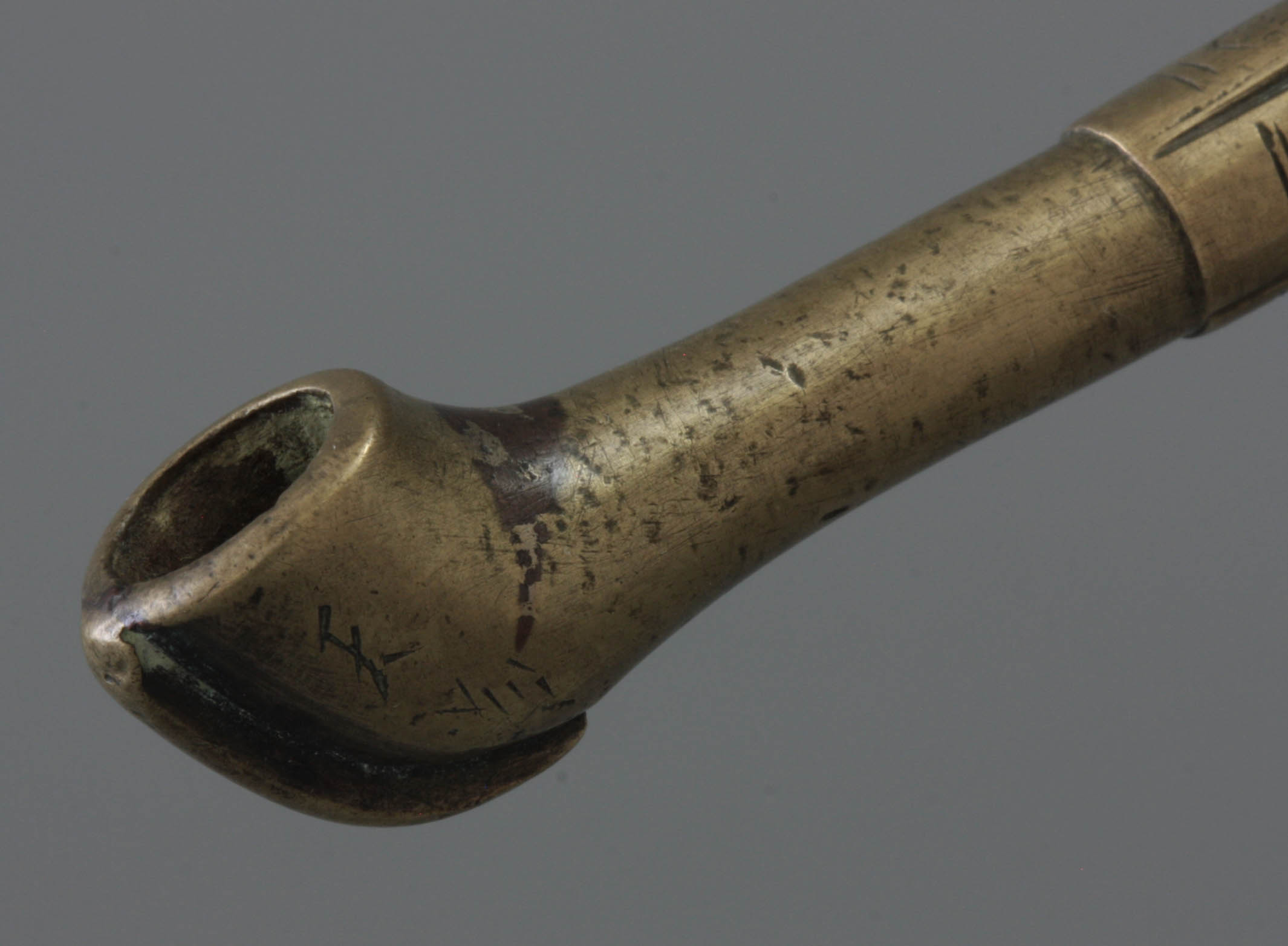
Around the year 1800 the so-called damper was introduced, a wide disk-shape opium pipe bowl enclosing a hollow space with a miniscule bowl at the top to place the opium. The opposite side is shaped as a short stem, which has to guide the smoke to the long pipe stem.
With the introduction of the damper, the standard opium pipe consists of two main parts. The tube, which we usually call the stem, is mostly in bamboo, but all kinds of material will do. In addition, there is the already reported bowl or damper. The attachment of both parts is not evident, since the round bamboo tube will not easily hold anything. Fixing is achieved by means of a so-called saddle, an elongated metal plate that closes around the stem with a kind of chimney just over a hole in the stem. The cuff-shaped trunk, soldered on the metal saddle, is where the short stem of the damper fits in. This saddle is attached airtight to the pipe stem with an adhesive, while the damper is clamped to the cuff of the saddle, being sealed with a piece of cloth. This can easily be removed for cleaning the pipe bowl.
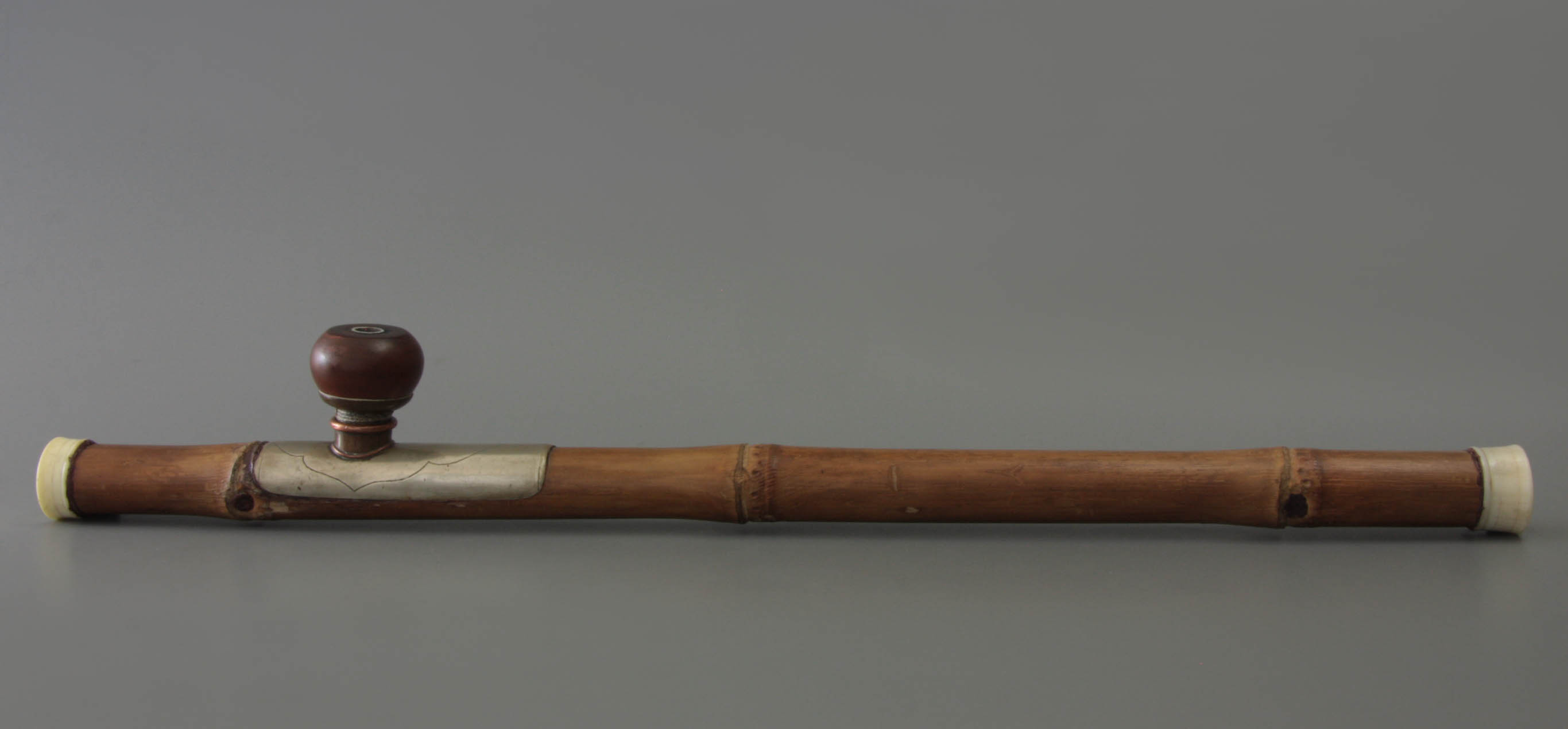
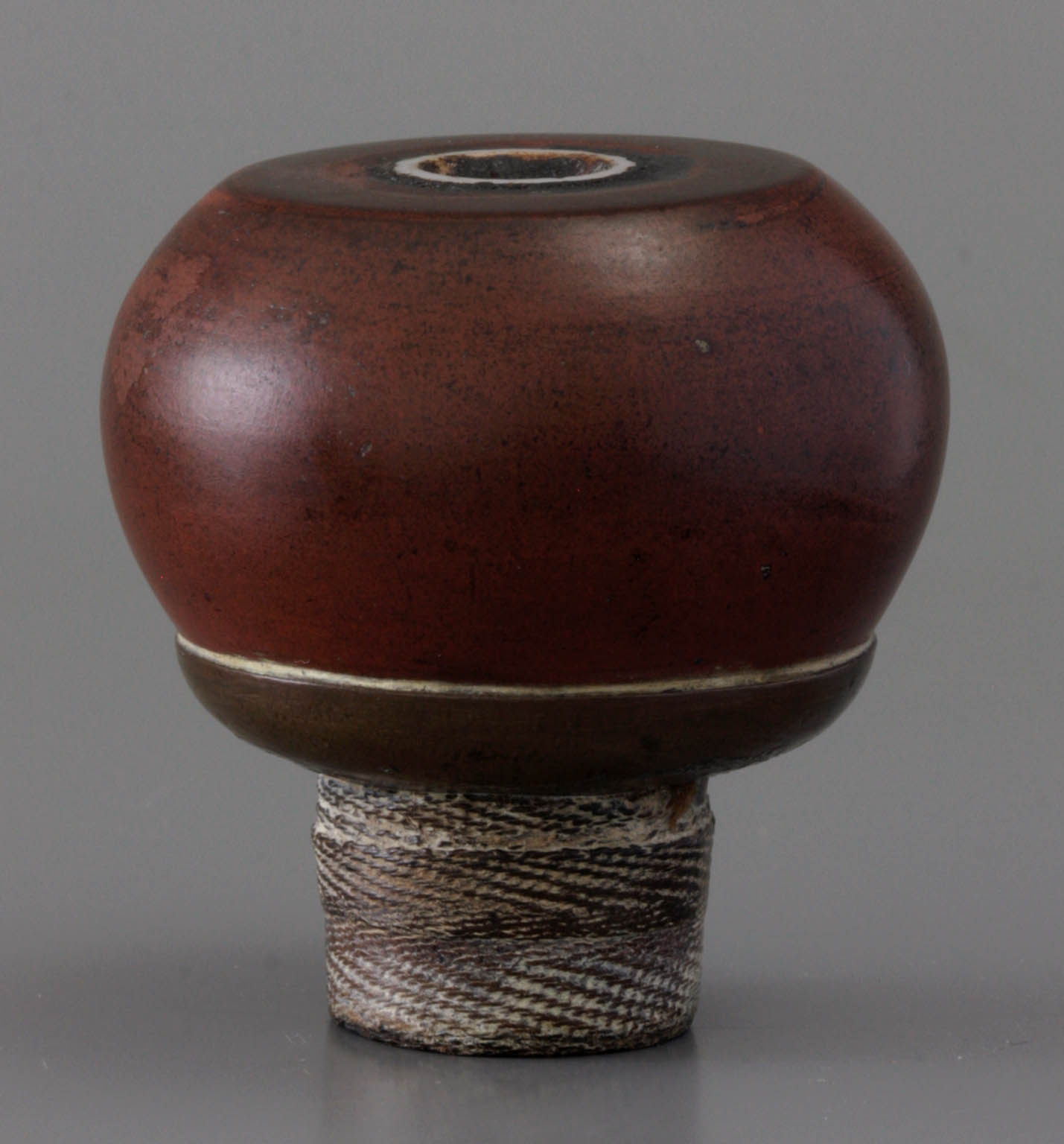
We distinguish two main types of opium pipes according to the position of the damper on the stem. Derived directly from the tobacco pipe is the damper that is placed at the end of the pipe stem. This pipe has the largest resemblance with the tobacco pipe and therefore seems to be the oldest. Curiously, the preserved examples of this type are usually of a somewhat later date. The characteristic Chinese opium pipe has a different contour. There the damper is placed at a quarter of the end of the stem as a very explicit crown of the pipe.
This typical opium pipe contour has been created in order to obtain a pleasant balance during use. The opium pipe is used in a completely different way than the tobacco pipe. To begin with, the pipe is not clamped between the teeth, the stem is too long and the weight too high for that. The long stem with an average length between 55 and 65 centimetres is held by both hands. The mouthpiece consists of a flat disc with a hole that is placed against the lips. In this hole, sometimes a straw is stuck as a stir. The hands of the opium taker must ensure the balance of the pipe. Opium smoking is done lying down and during the ceremony the damper is turned sideways above the flame of the opium lamp. This flame heats the opium until the moment of evaporation. The smoke that is released during this process is inhaled through the stem.
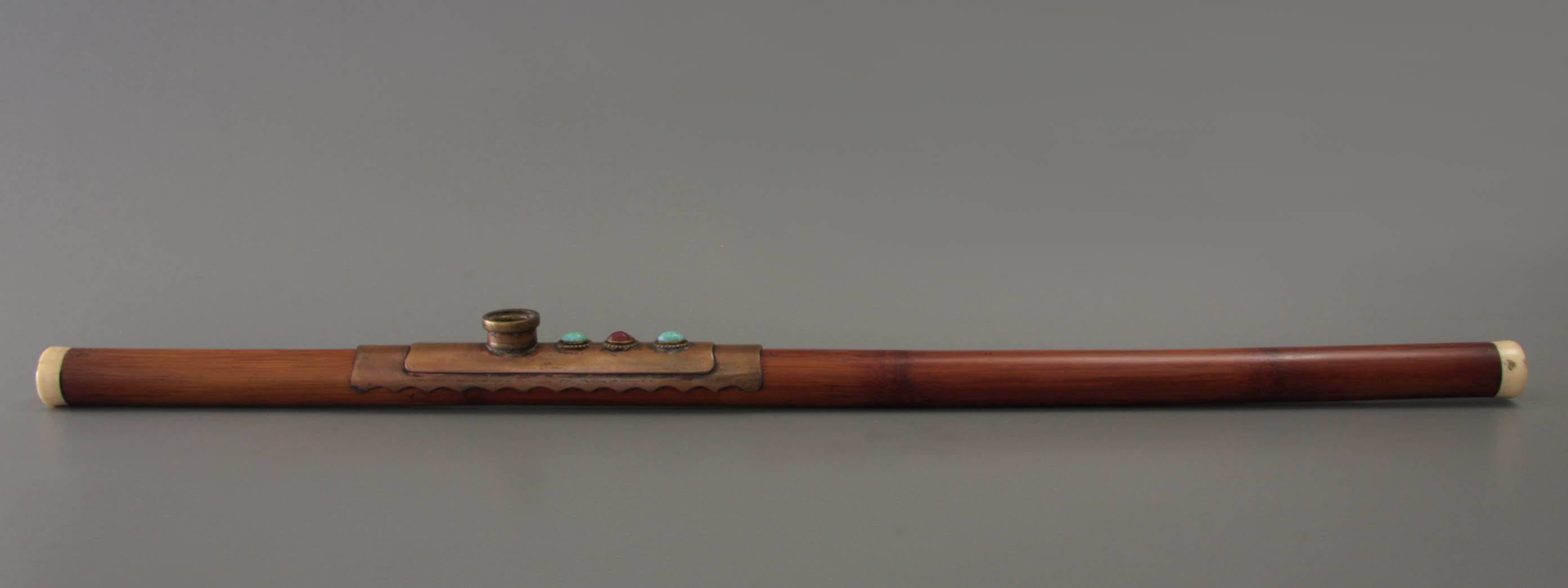
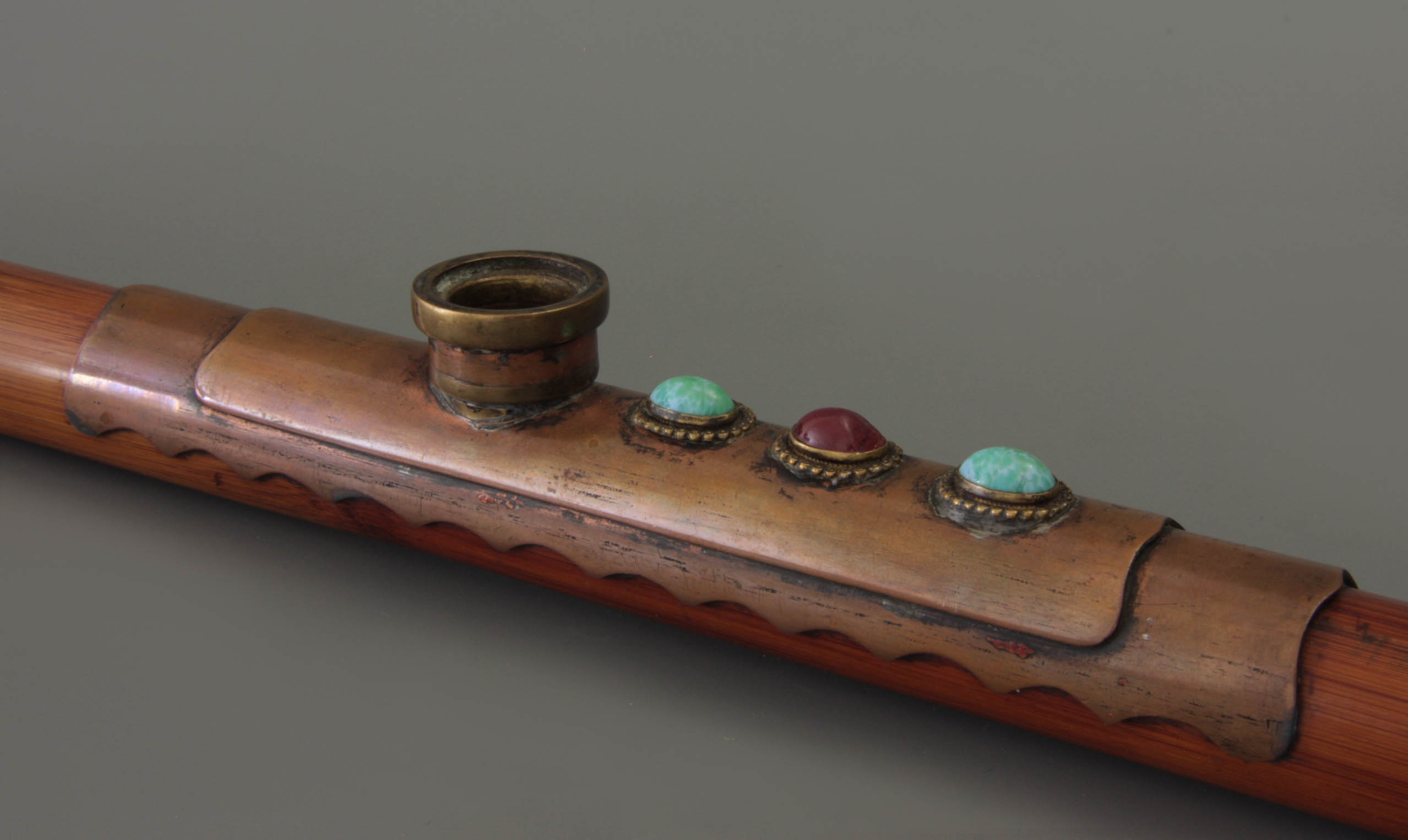
The materials used for the opium pipe are countless. In its simplest form the tube can be of sugar cane, a material that is not always easy to distinguish from bamboo (Fig. 2). Naturally, this less sustainable plant stem is not very durable. Bamboo is the most commonly used since this material is available everywhere and, like the sugar cane stalk, is hollow by nature (Fig. 3). Sometimes the pipe maker gratefully uses the discs separating the sections in the bamboo and even the start of a twig turns into a delicate piece of carving, which becomes a fixation point for many opium pipes. This button provides support when turning the pipe bowl to the flame of the opium lamp. In other cases, the thickened nodes are carefully ground away in order to create a long, straight, profile-free tube. Besides bamboo we come across different types of wood. The fruitwoods are sometimes so treated that they closely resemble bamboo. In some examples, even the nodes of the bamboo have been imitated as constrictions, as is the bud-shaped leaf onset. More special products are made of tropical woods, where the black ebony is the most attractive.
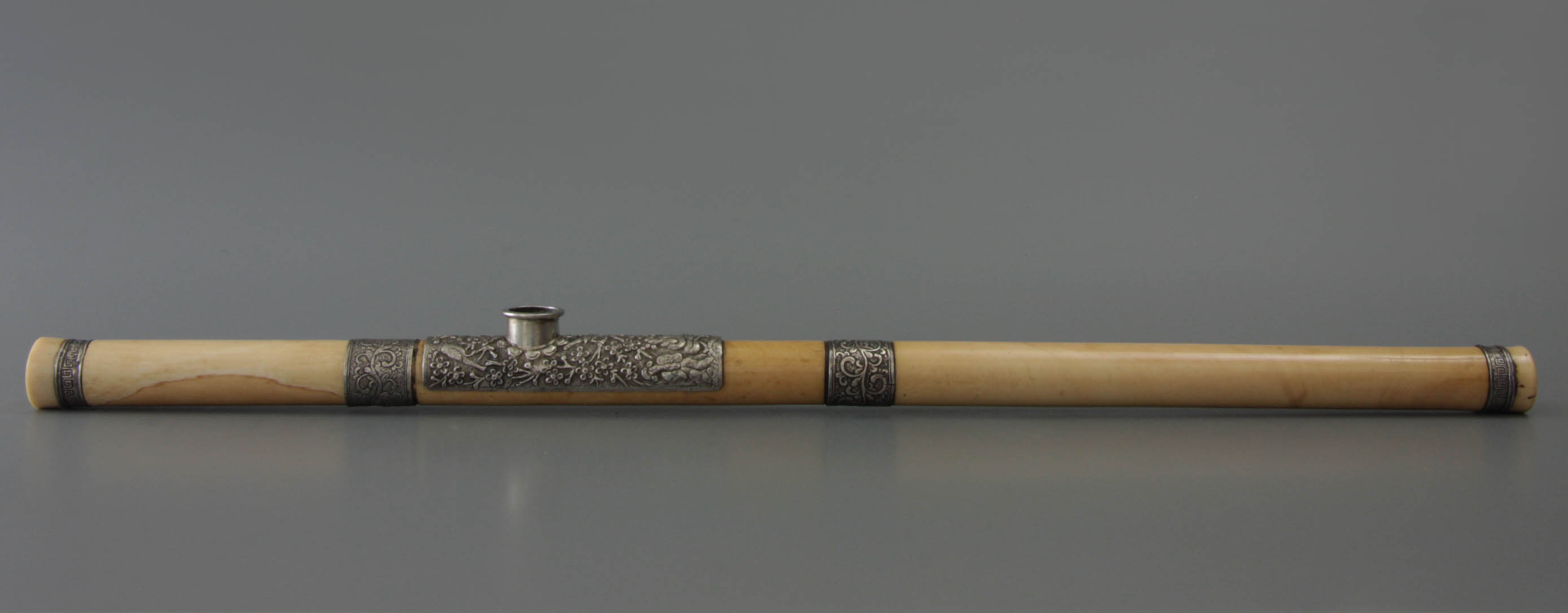
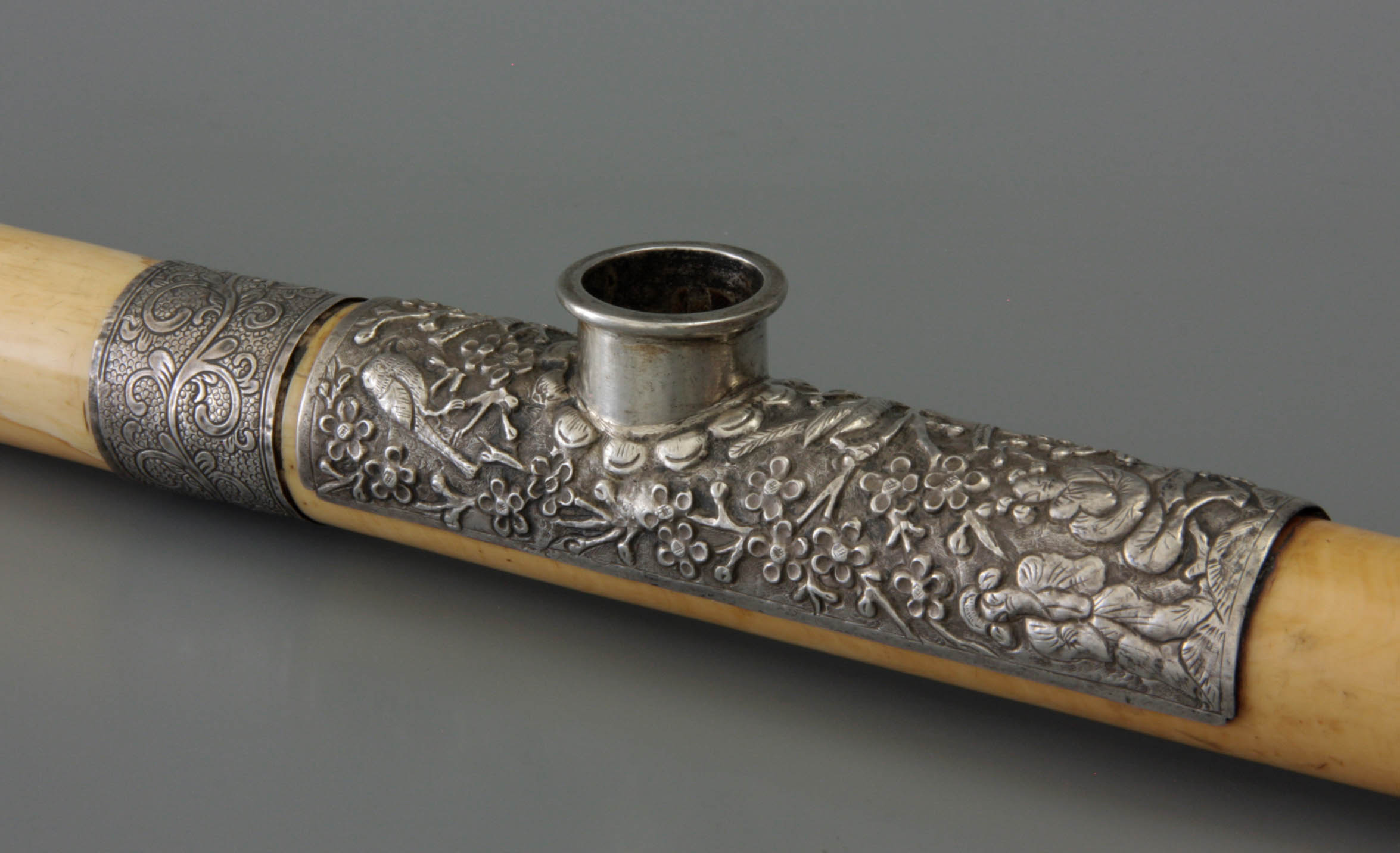
In addition to bamboo and wood, ivory is a popular material (Fig. 4). Ivory is characterized by a relatively large weight and usually such pipes have a narrow flue. Due to frequent use, the ivory is permeated with the tar-like substance and gets a beautiful patina. Bone pipes, dating from a later period, have a somewhat colder look by the nature of its colour. Ivory and bone are suitable for carving and engraving. Especially bone pipes offered in the vicinity of tourists opium kits became typical. They consist of five segments engraved with characteristic Chinese representations of which the scene with the eight immortals is the most common (Fig. 5). The engraving is highlighted by rubbing with black ink.
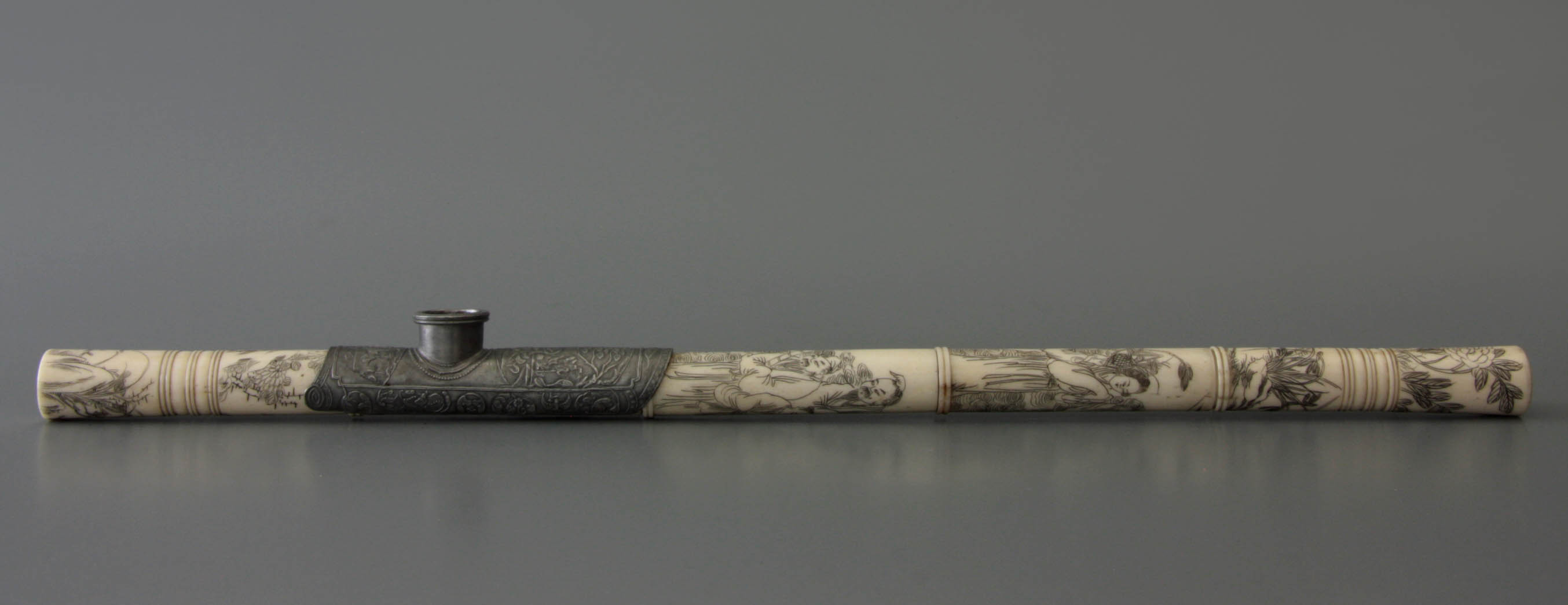
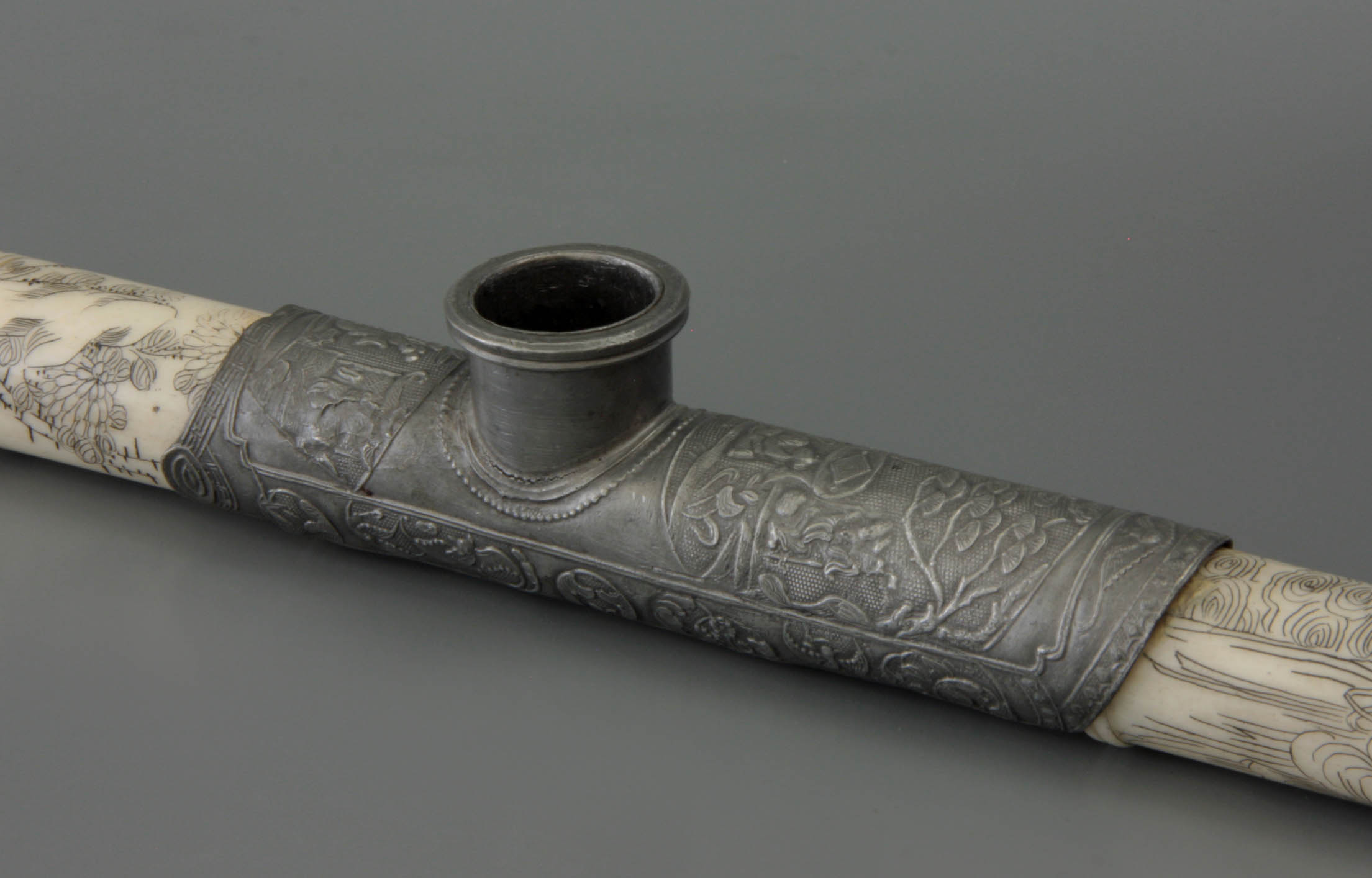
An attractive material is buffalo horn, which is well turned and gets a beautiful shade and shine through colour and polish (Fig. 6). Many such opium pipes are built up from different parts which are arranged around a core of soft wood. Less common are pipes covered with turtle shell (Fig. 7). In assessing the latter, however, one must be particularly attentive, since celluloid has been used instead of tortoise since 1870, which is hardly distinguishable from turtle in view of its appearance. The clearest difference is that with celluloid the seams are connected without an irregular pattern. Another suitable, but rare material is polished shark skin, which is often applied in green, sometimes also in gray.
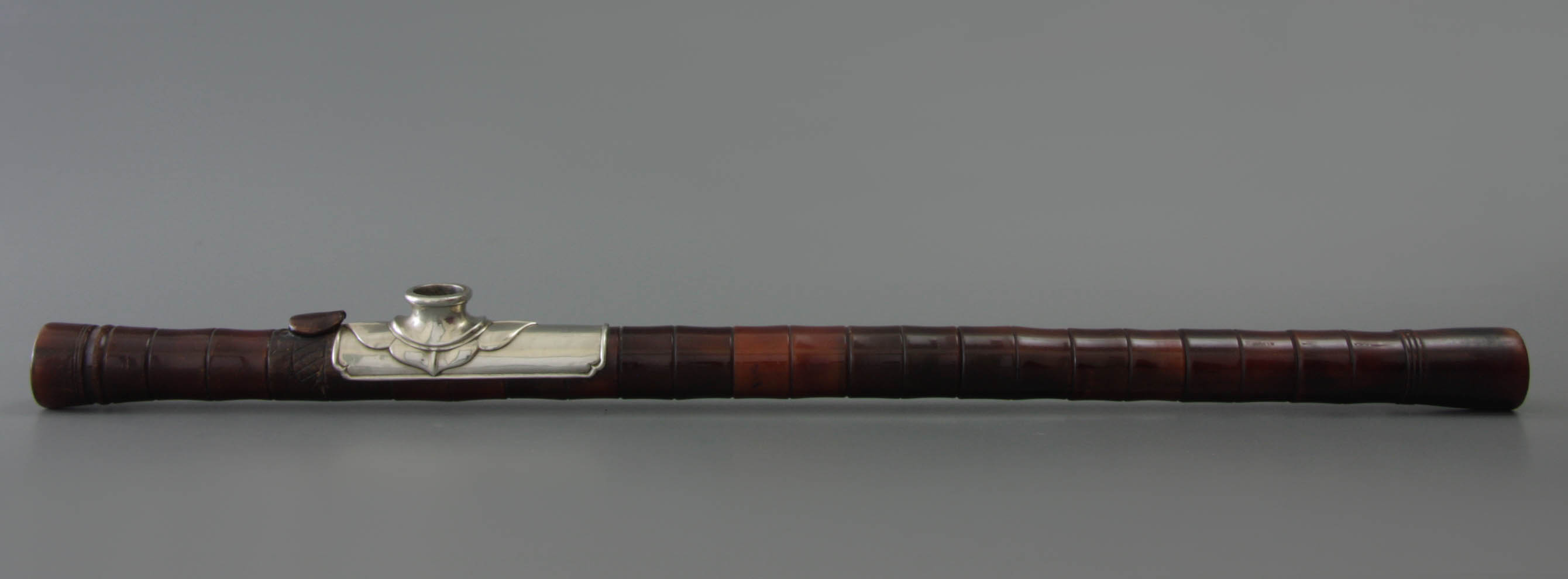

Finally, there are some less common materials. The characteristic white metal, the so-called paktong from the province of Yunnan, was also used for opium pipes. Often these pipes can be unscrewed in parts and are stored in a travel necessary. Metal can also be executed in enamel cloisonné. Rare opium pipes are entirely made of jade and have a beautiful transparent appearance. In addition, pipes made of porcelain do exist, although they have been handed over in limited quantities because of their fragile nature.
Virtually all opium pipes have end pieces of a stronger material, making them more impact-resistant and more comfortable to the lips at the same time. Discs of ivory and bone are the most common. More luxurious are the stops or end pieces of jade. These parts are attached to the stem with a glue like varnish. With these more sustainable materials, we often see a reuse when the stem itself had deteriorated, where sometimes the diameter has to be adjusted.
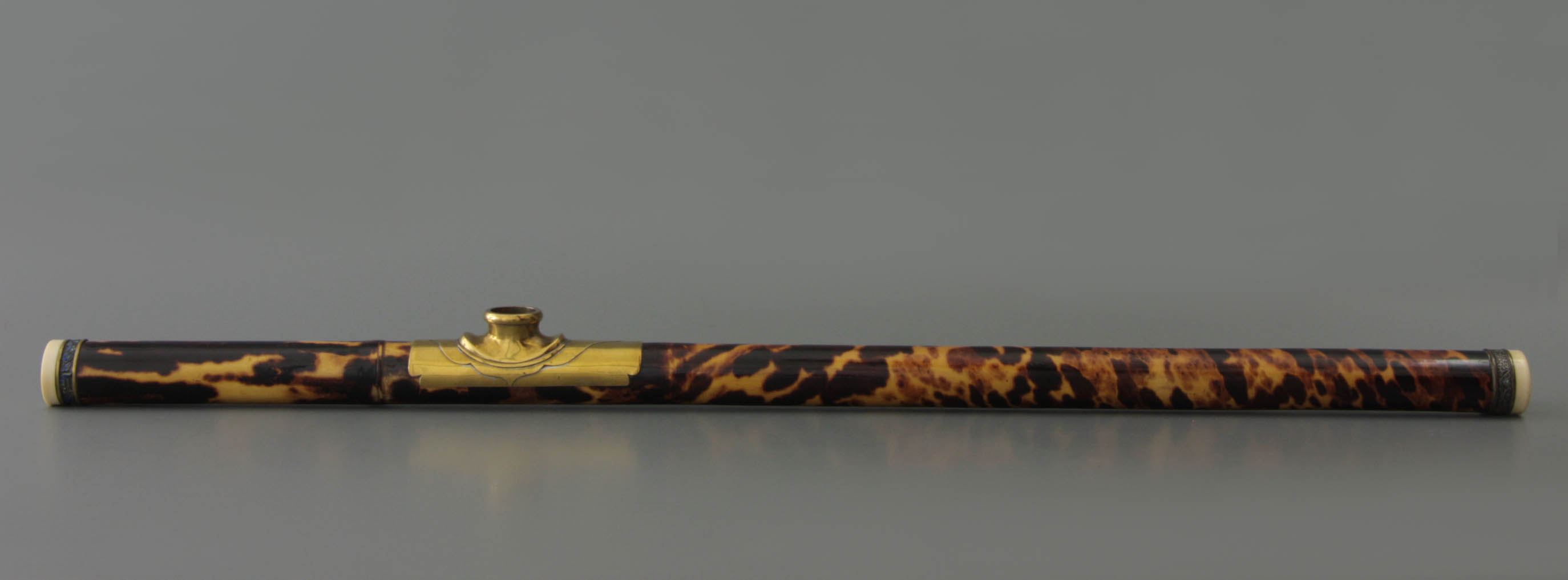
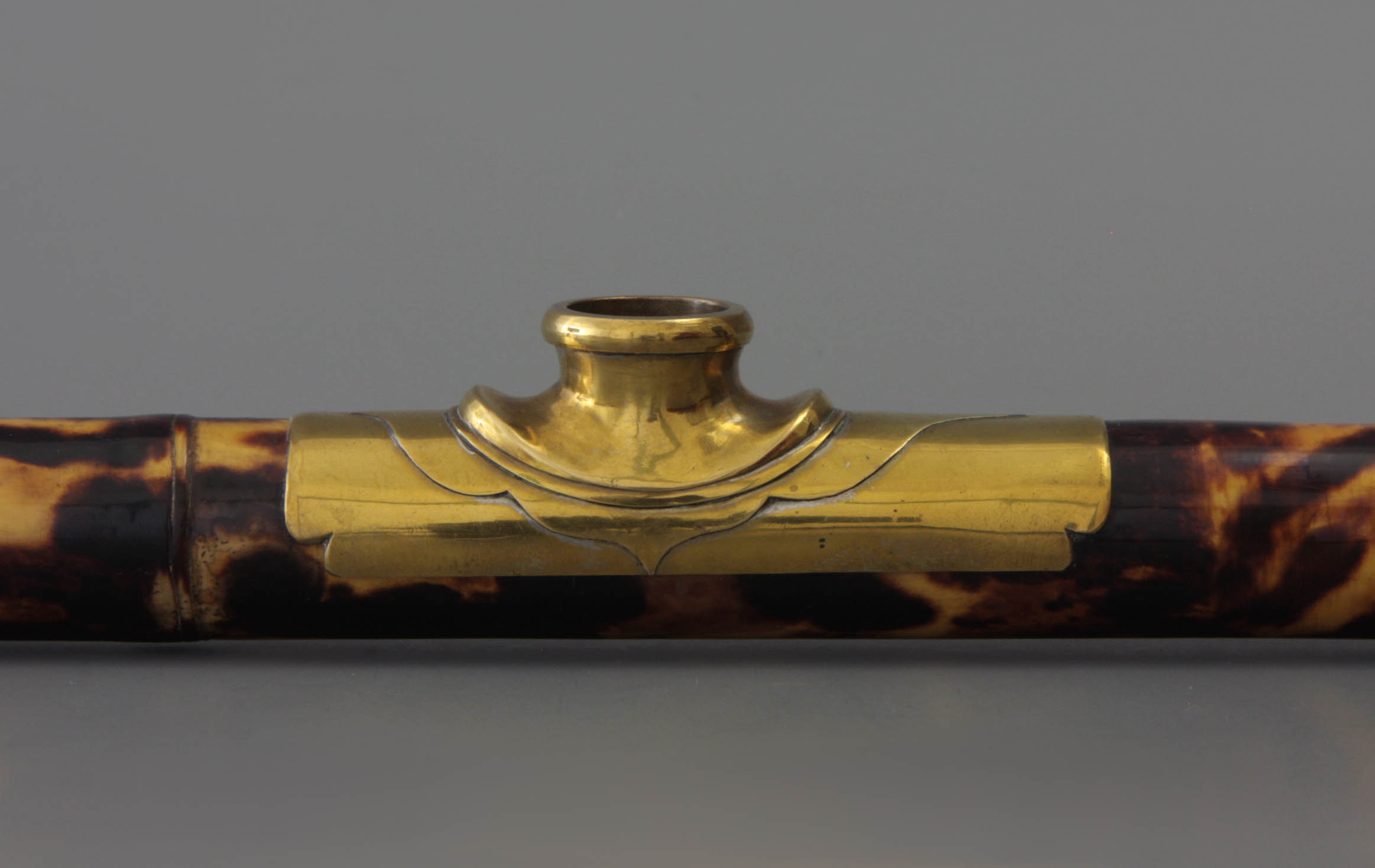
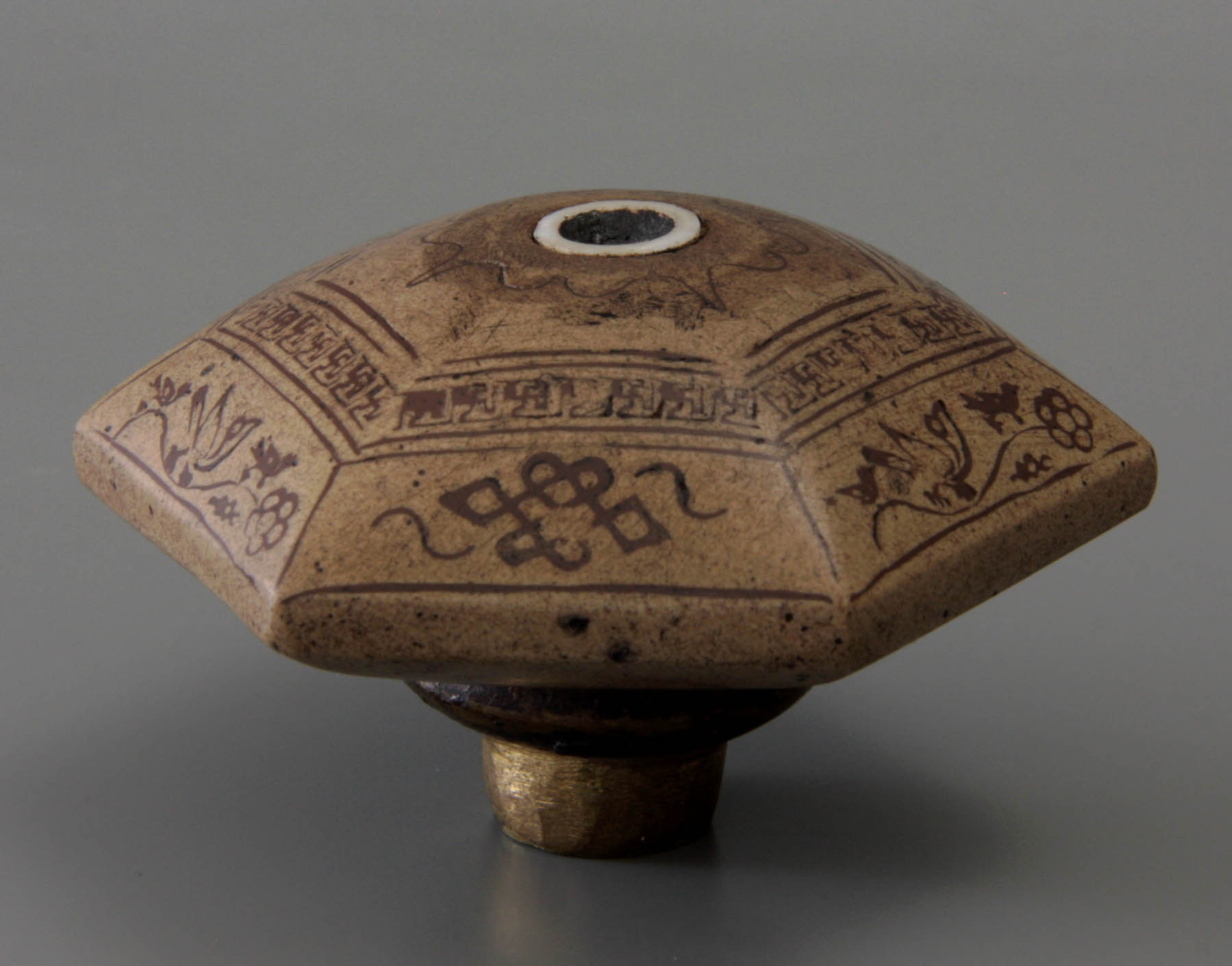
A delicate part of the opium pipe is the saddle. This is always made of metal, but is again characterized by a large variety of designs. The sugar cane pipes usually have a tight and simple saddle of base metal. The white metals, an alloy of zinc, nickel and sometimes a fraction of silver are popular and can have ornamental contour lines. At the top they are often set with cabochon cut ornamental stones. In addition brass and copper combinations occur. The inexpensive metal saddles are single pieces of metal, while attractive colour combinations are the more luxurious counterparts. Then the sheet metal shows subtle forms and the different layers partly overlap. This creates an exciting interaction between profile lines and metal shades.
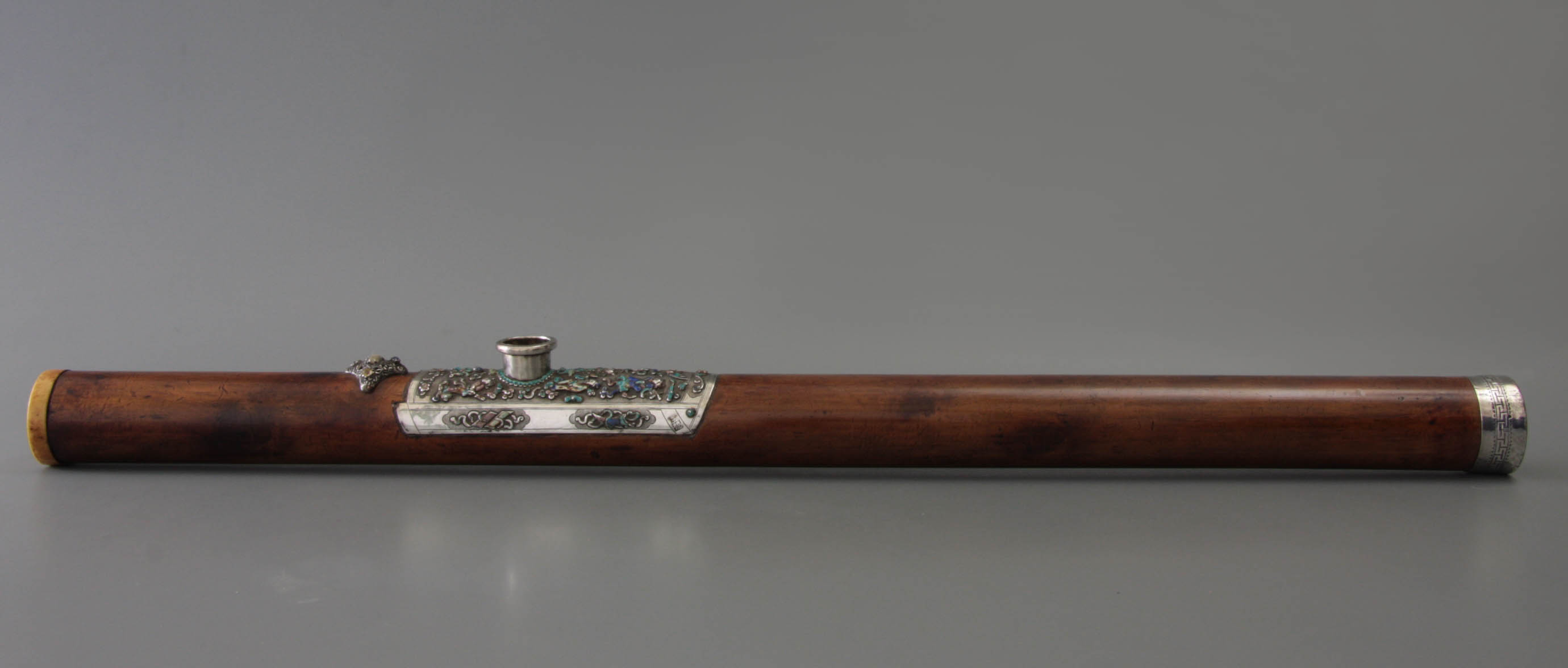
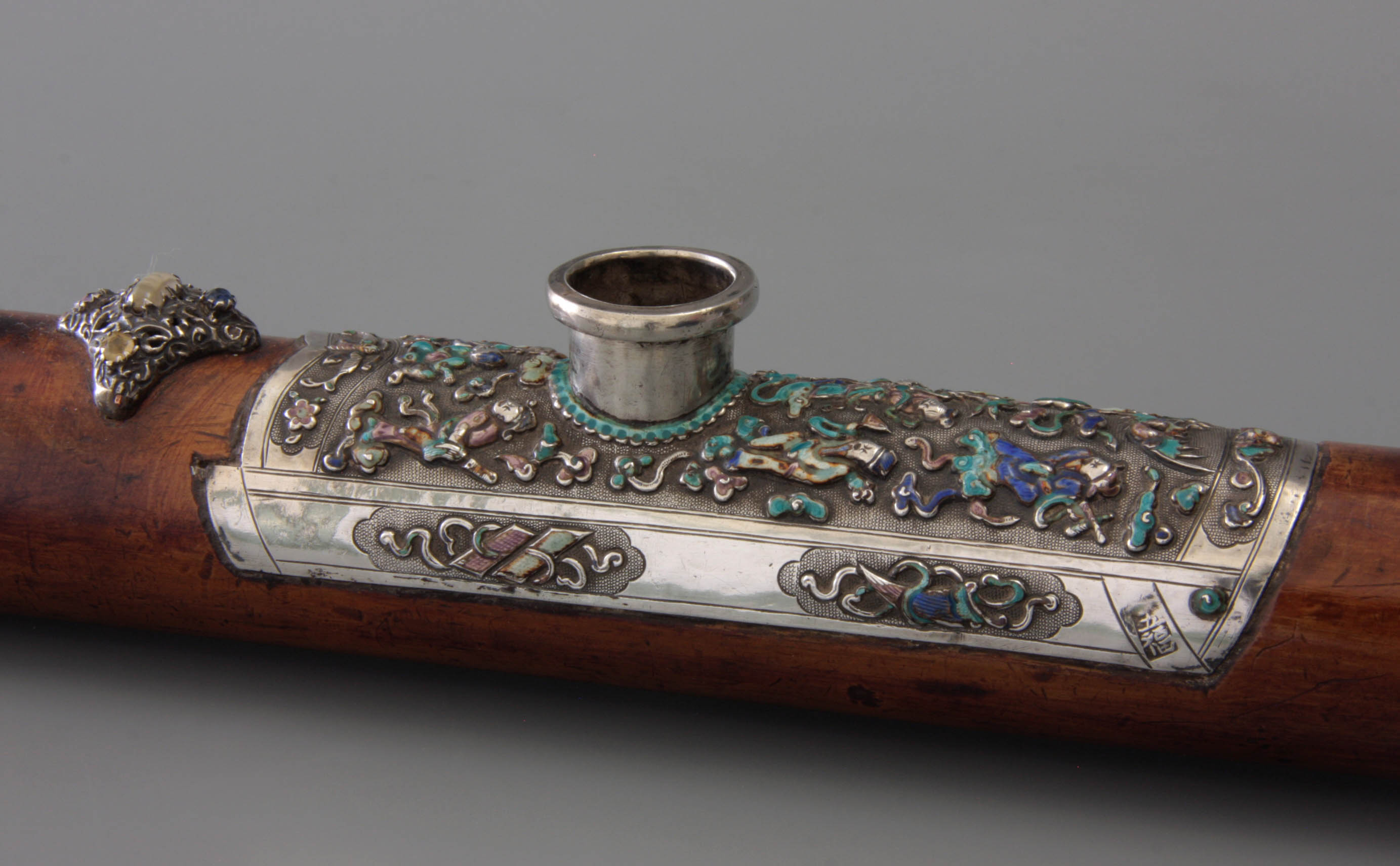
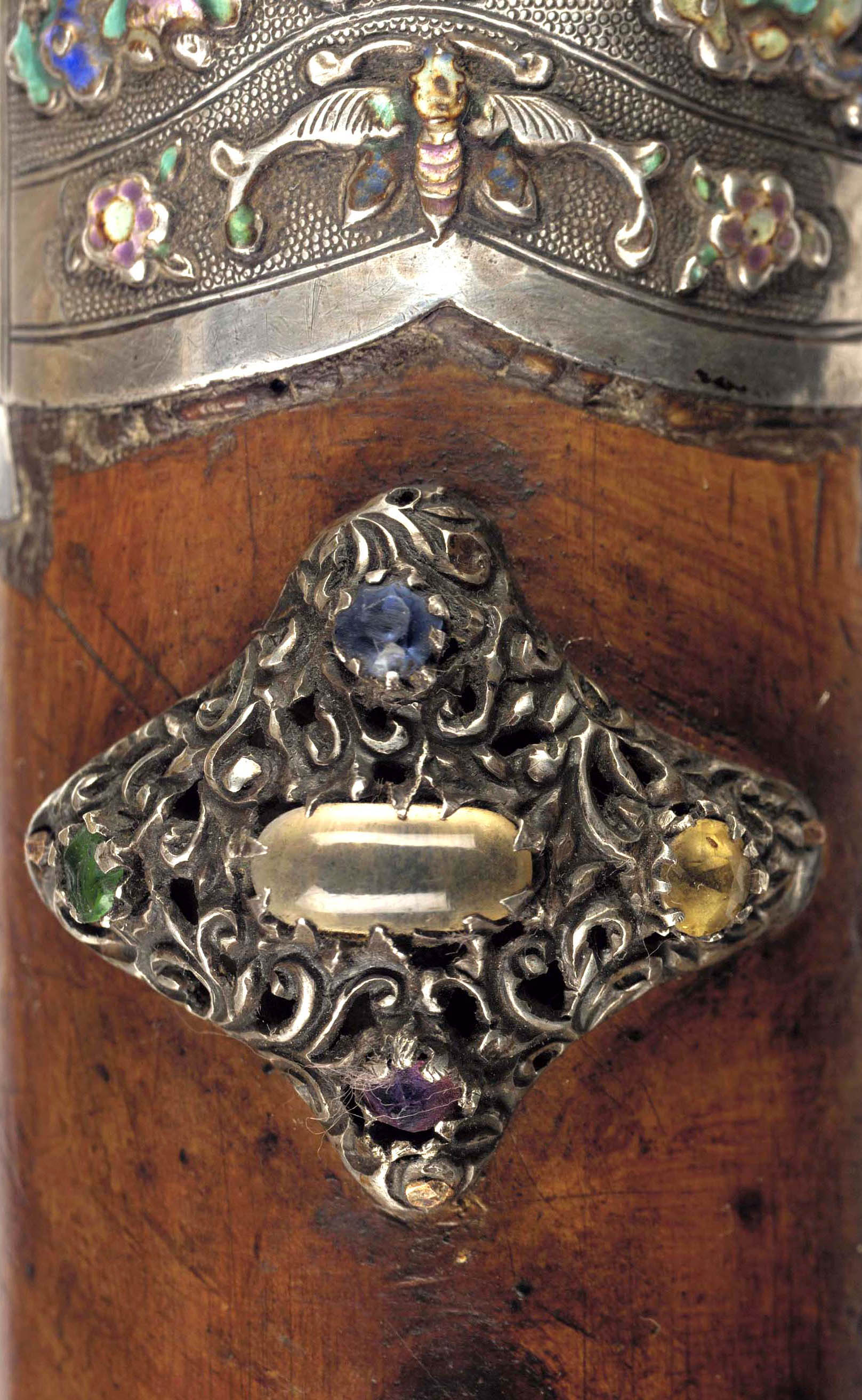
The saddle of the most luxurious opium pipes are in precious metals. A rare saddle is made in silver or sometimes even in gold. These softer metals are easy to emboss, creating decorative representations of bamboo shoots or even scenes with animals or persons. An extraordinary saddle has even been heightened with multi-coloured enamel (Fig. 8). By the end of the nineteenth century, a new type of saddle was made in an alloy of lead and tin. These are mainly applied to the touristy bone pipes. They are in their own way attractive because of the meticulous relief decoration, which was applied in a mould and cast in series.
Although the saddle is primarily the holder for the pipe bowl, it is at the same time the aesthetic focal point of the complete pipe. For its functional purpose, firmness is a prerequisite. This is expressed in the plate shape around the stem, but especially in the cuff, which is regularly provided with elegant circumferential lines. But as said, we should not consider the saddle merely as a necessary connection between the stem and the damper, but appreciate how the simple but functional lines enhance the way this shiny element makes a perfect connection between the two different materials of the stem and the damper. At the same time we can take a closer look to the decoration and see how its details attract our attention to the centre of the long pipe.
The damper
The pipe bowl or damper is the crowning of the opium pipe. The most suitable material for it is ceramic. Since the Chinese are masters in ceramic art, we find a wide range of samples of skilled craftsmanship, which constitutes the a survey of the Chinese ceramics in all its facets.
The most specific feature of the opium damper is the miniscule bowl at the top in which the opium ball is vaporized. Often this fragile thin part of the bowl is broken by a needle while cleaning. The resulting hole is then brought back to diameter with a loose insert. Such an inner bowl is made of metal, ceramic or cut shell. If the bowl opening is damaged again, this item can easily be replaced. The interior of the bowl is hollow and functions as a cooling space for the released smoke before it is inhaled. When smoking, the opium residue runs along the inside of the damper where it forms a layer. With a metal scraper, this residue is scraped away from time to time.
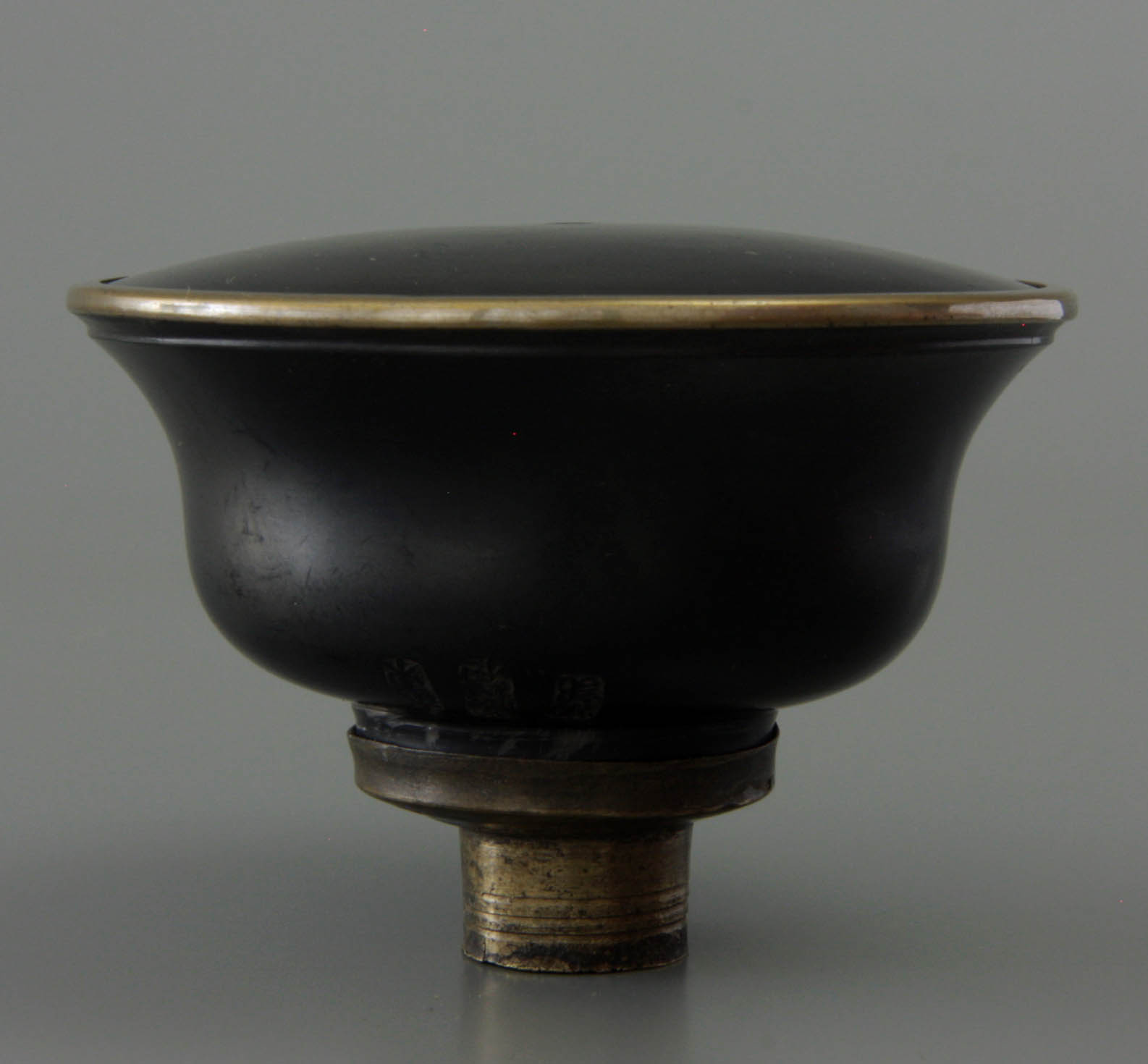
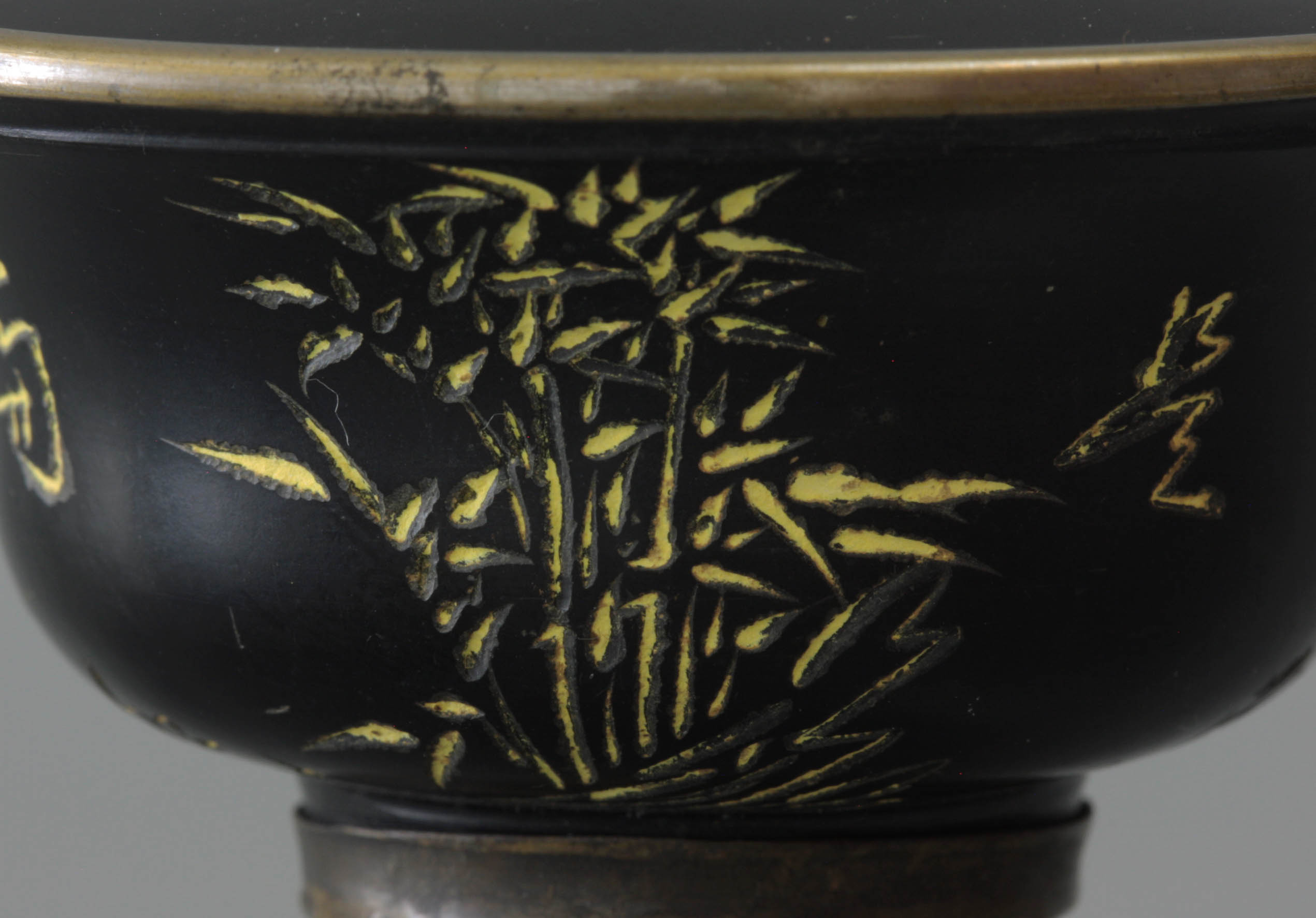
The most common are the ordinary dampers in earthenware. These are made on the potter’s wheel and are usually red in colour. In addition to red, black-backed versions occur. Initially the short stem is made on the turntable, but for the sake of firmness the stem is generally made of metal and is glued to the ceramic pipe bowl with a dish-shaped holder. The craftsmanship of these dampers is particularly evident from the care for the finish. The ceramic is thin-walled and extensively polished. The maker's pride is expressed in a impressed character or a series of marks, usually placed in a contour.
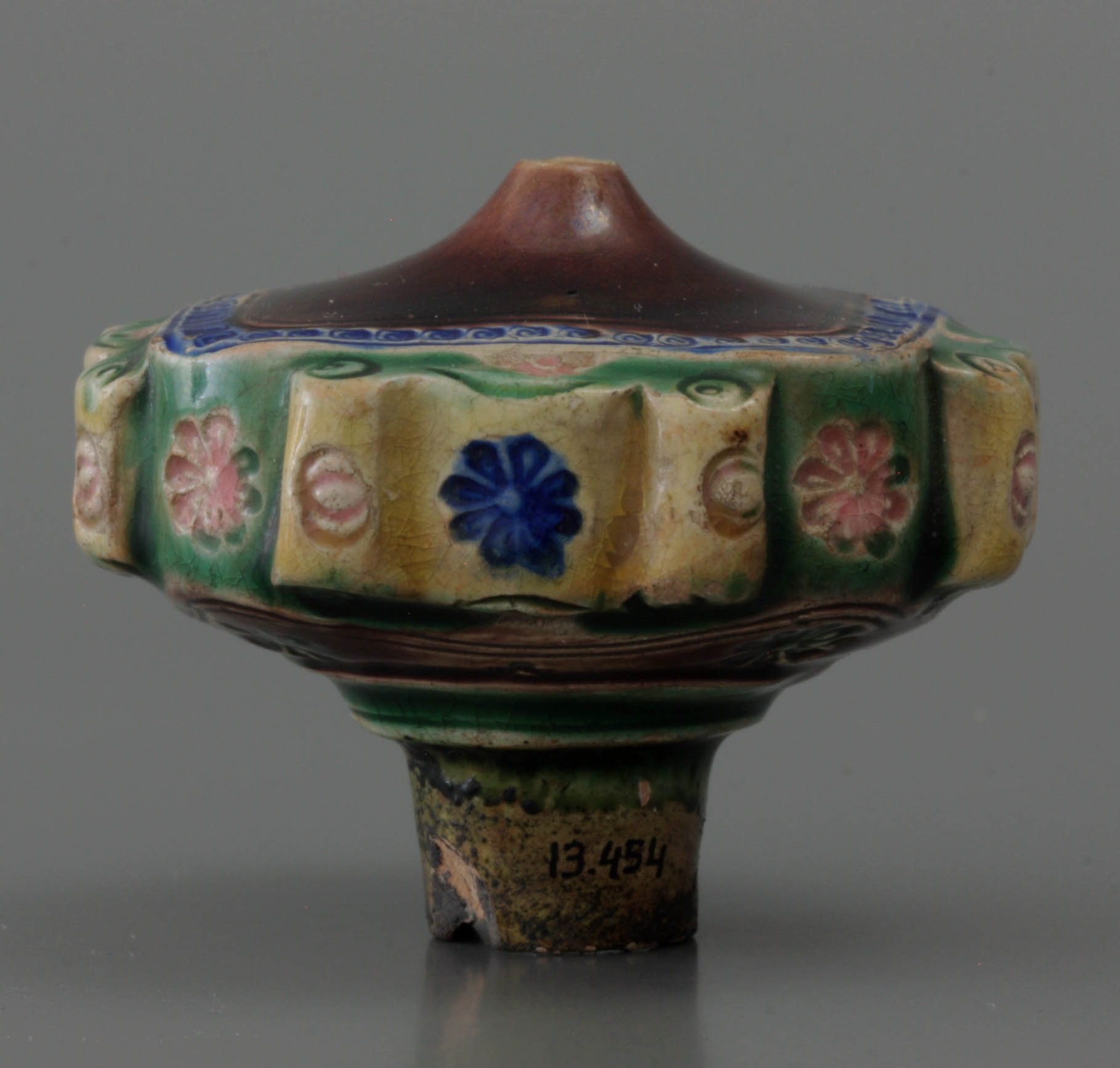

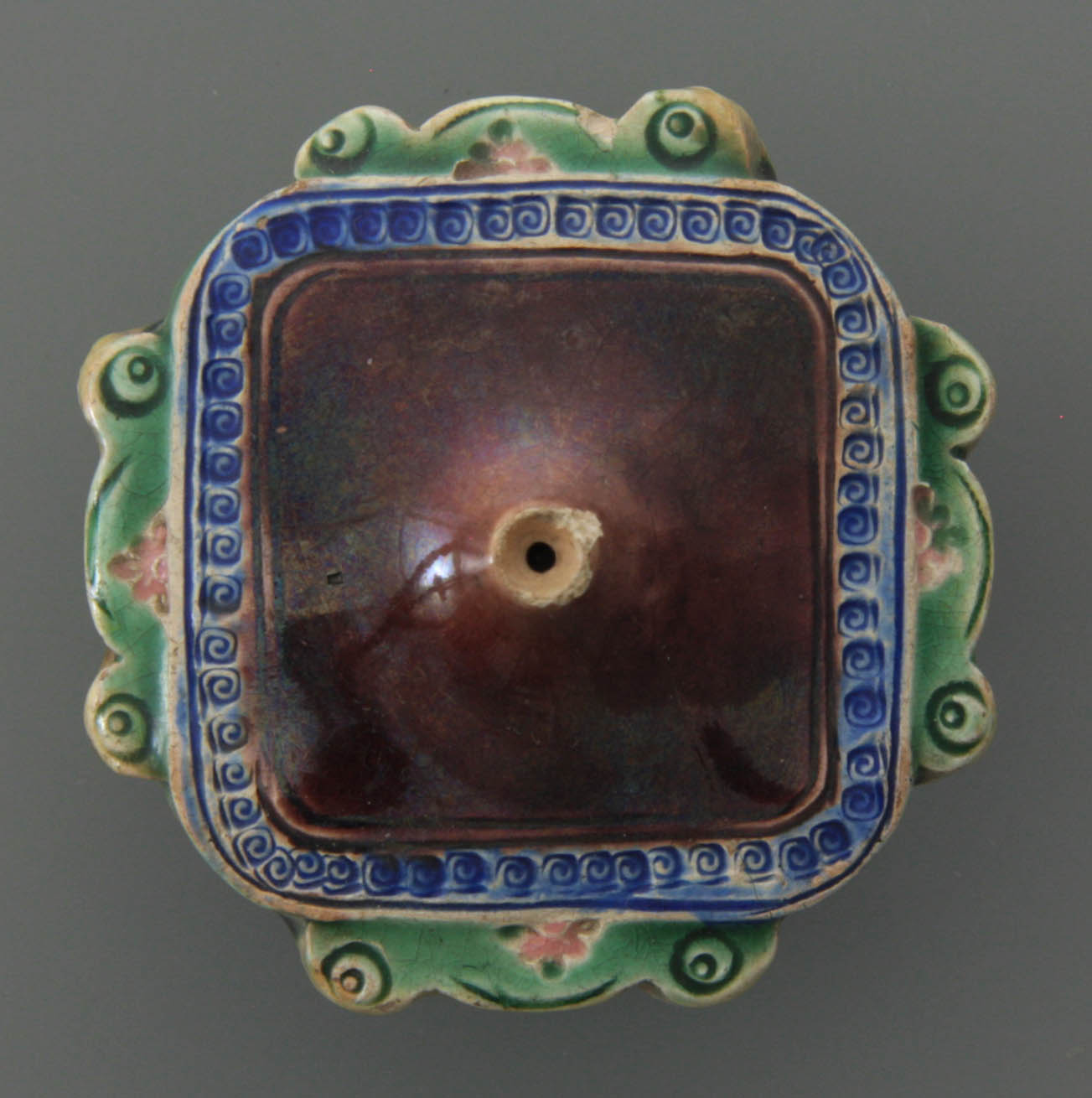
The simple earthenware pipe bowl can be decorated with a voluminous incised decoration, the lines of which are filled with coloured chalk after baking. Sometimes a metal band is placed around the outer line as a fringe (Fig. 9). Rare is the ceramic damper in the so-called wu ts'ai technique, a five-colour glaze. They are a more luxurious, because in addition to twisted contour lines and embossed stamps, a multi-coloured glaze is applied (Fig. 10). These pieces date from the earliest period of the damper and still have a stem of ceramic. After 1880 there is a renewed interest in working with glazes and also these dampers have a ceramic stem, albeit as a simplification.
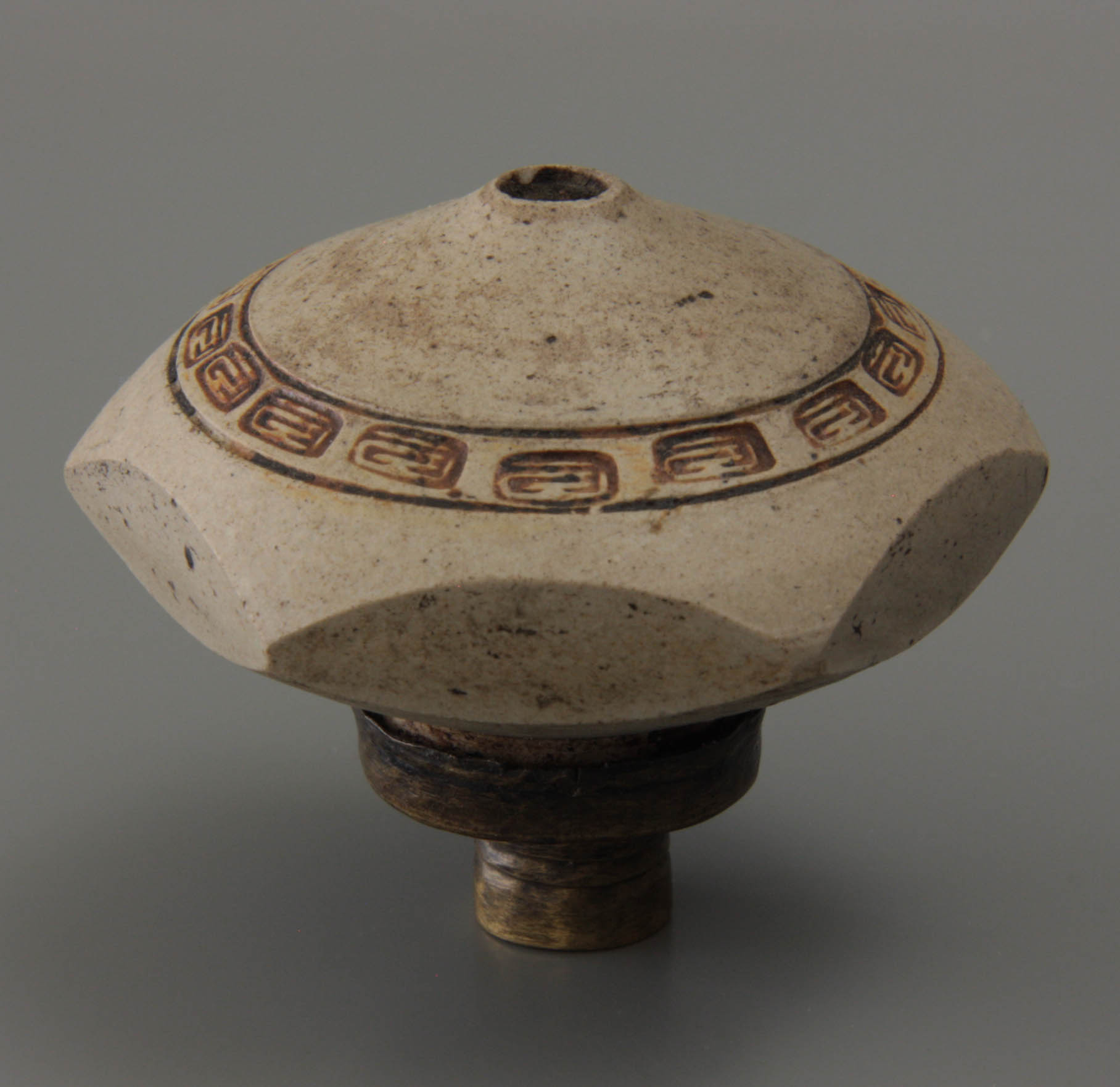
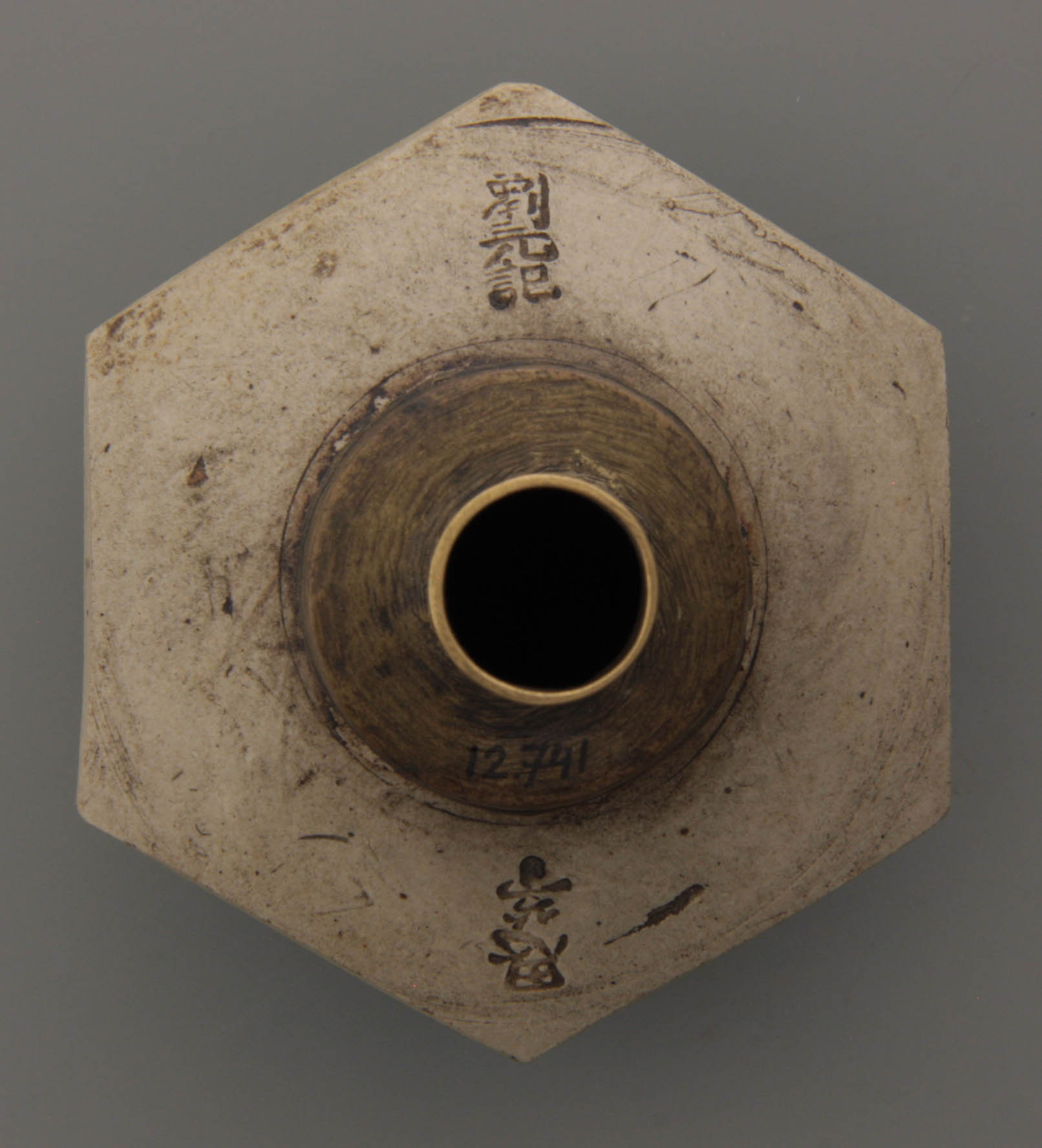
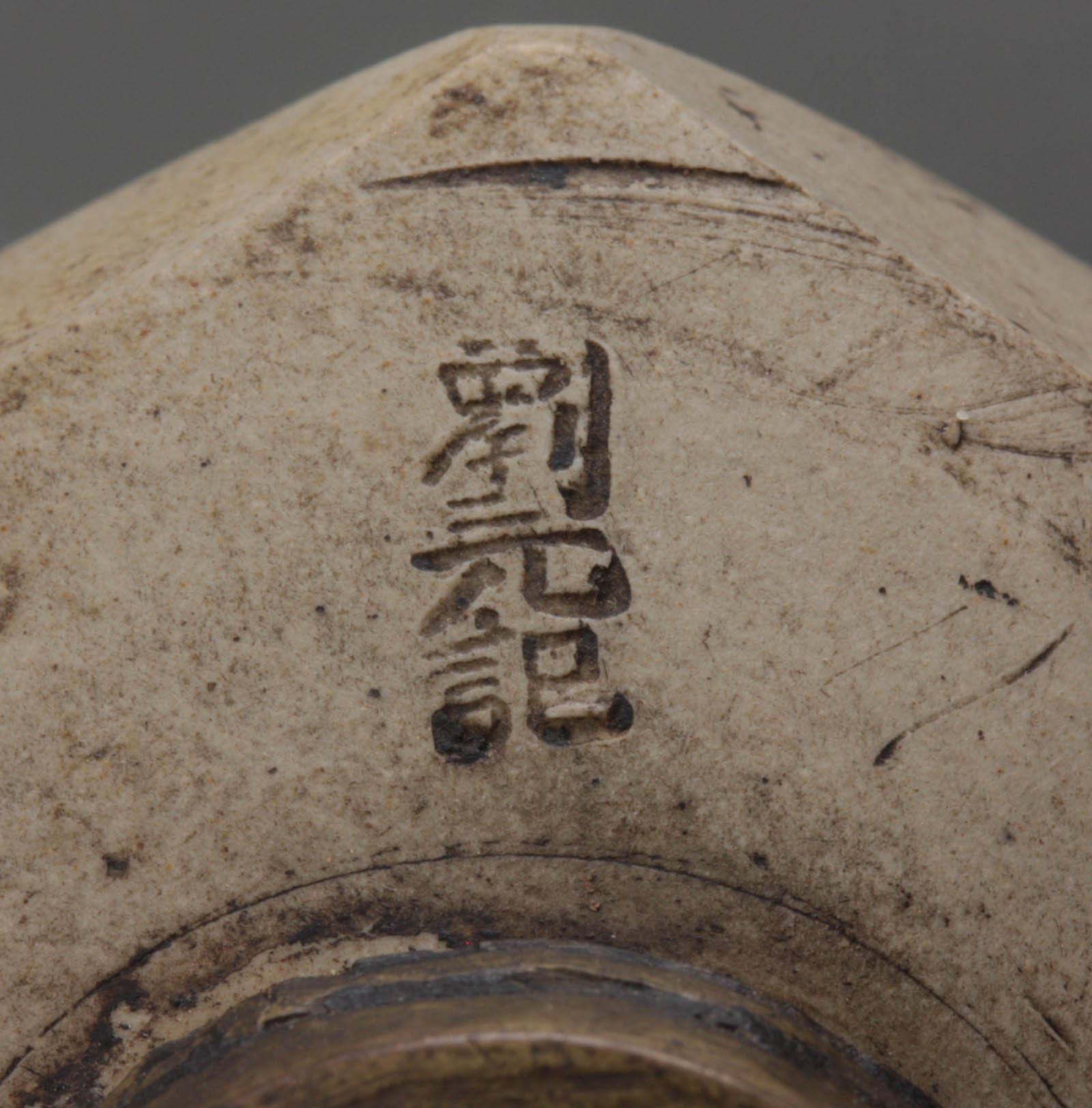
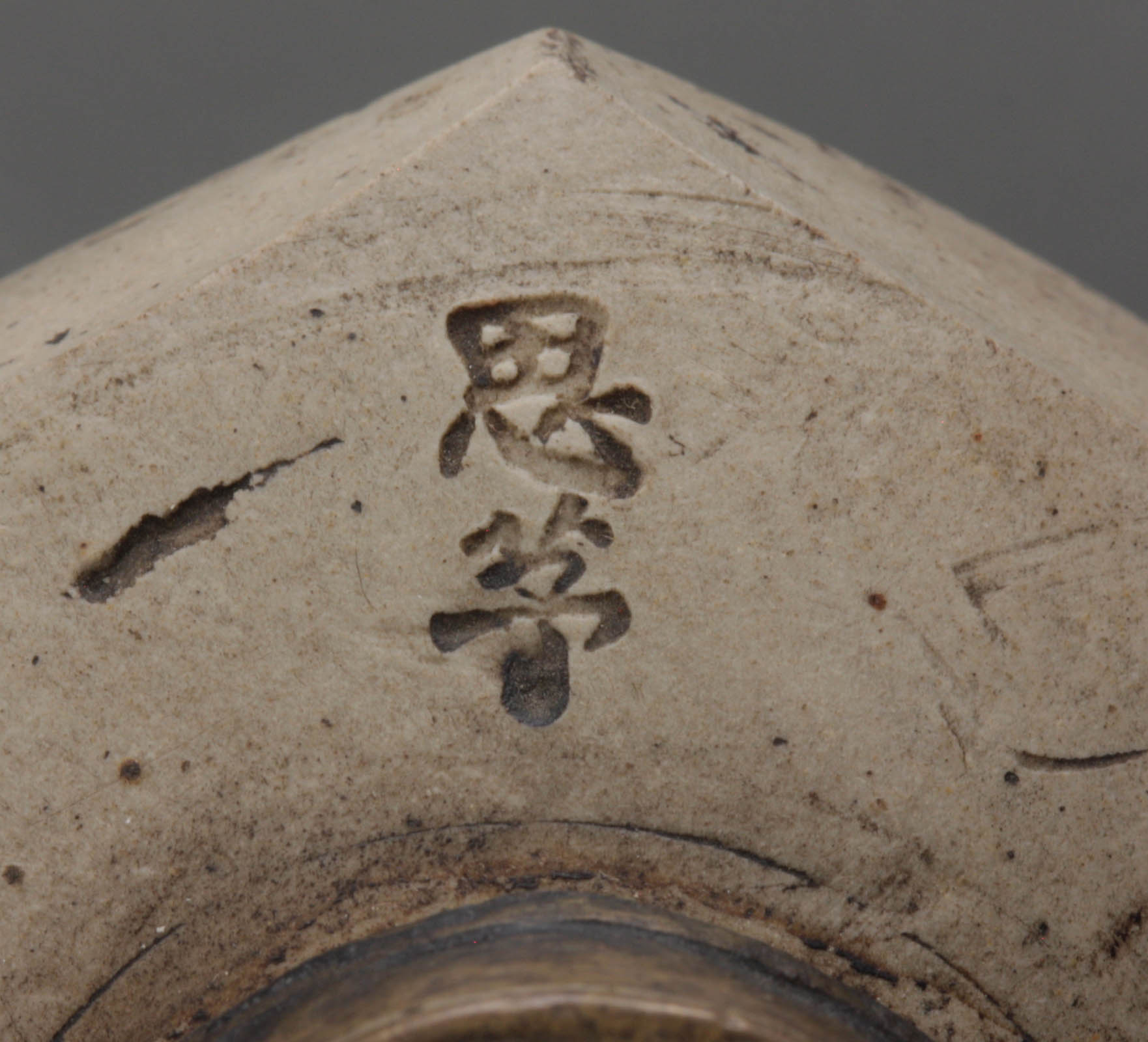
For the Chinese opium pipe, the stoneware damper is the most characteristic, a ceramic technique in which the greatest merit has been achieved. The material is indicated by yixing to the eponymous region about one hundred kilometres west of Shanghai. This stoneware has been in production since the Ming period, especially for tea pots. A big difference between the tea pots and the opium damper is the thickness of the shard. While the yixing tea ware requires a thin-walled product, the dampers for opium have heavy shards for better cooling. Legend has it that four potters' families were involved in the production of these pipe bowls. A multitude of shapes and styles has been created through turning, pressing and casting. The clay is always carefully finished and polished on the outside until a mirror-smooth hard surface was created. This surface is then finished with twisted concentric lines or a stamped repetitive geometric motifs. Series of makers marks in the form of Chinese characters are placed on the base around the stem (Fig. 11). They consist of two and sometimes even three or four groups and relate to the name and address of the maker, the kiln and the time of production.
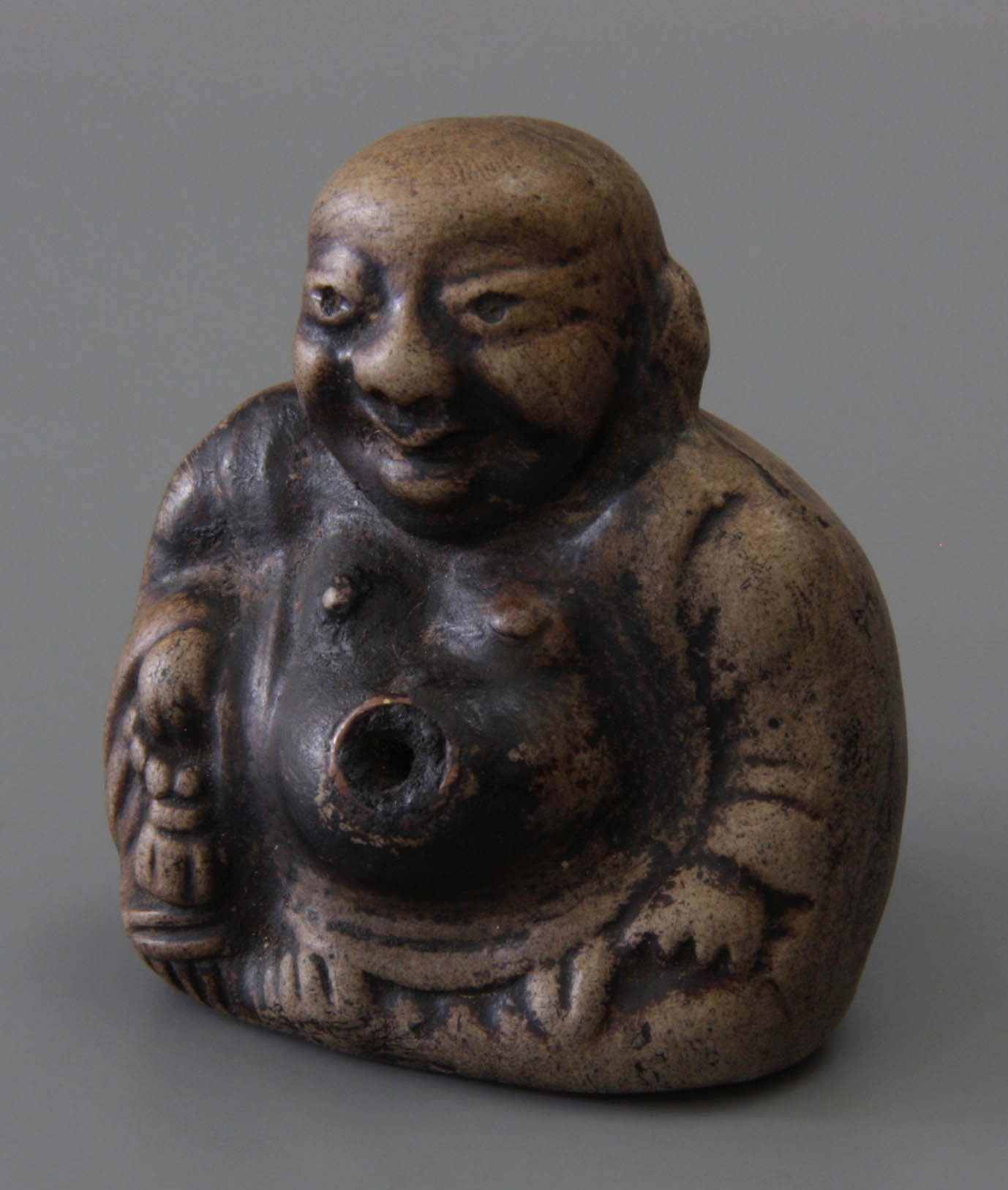
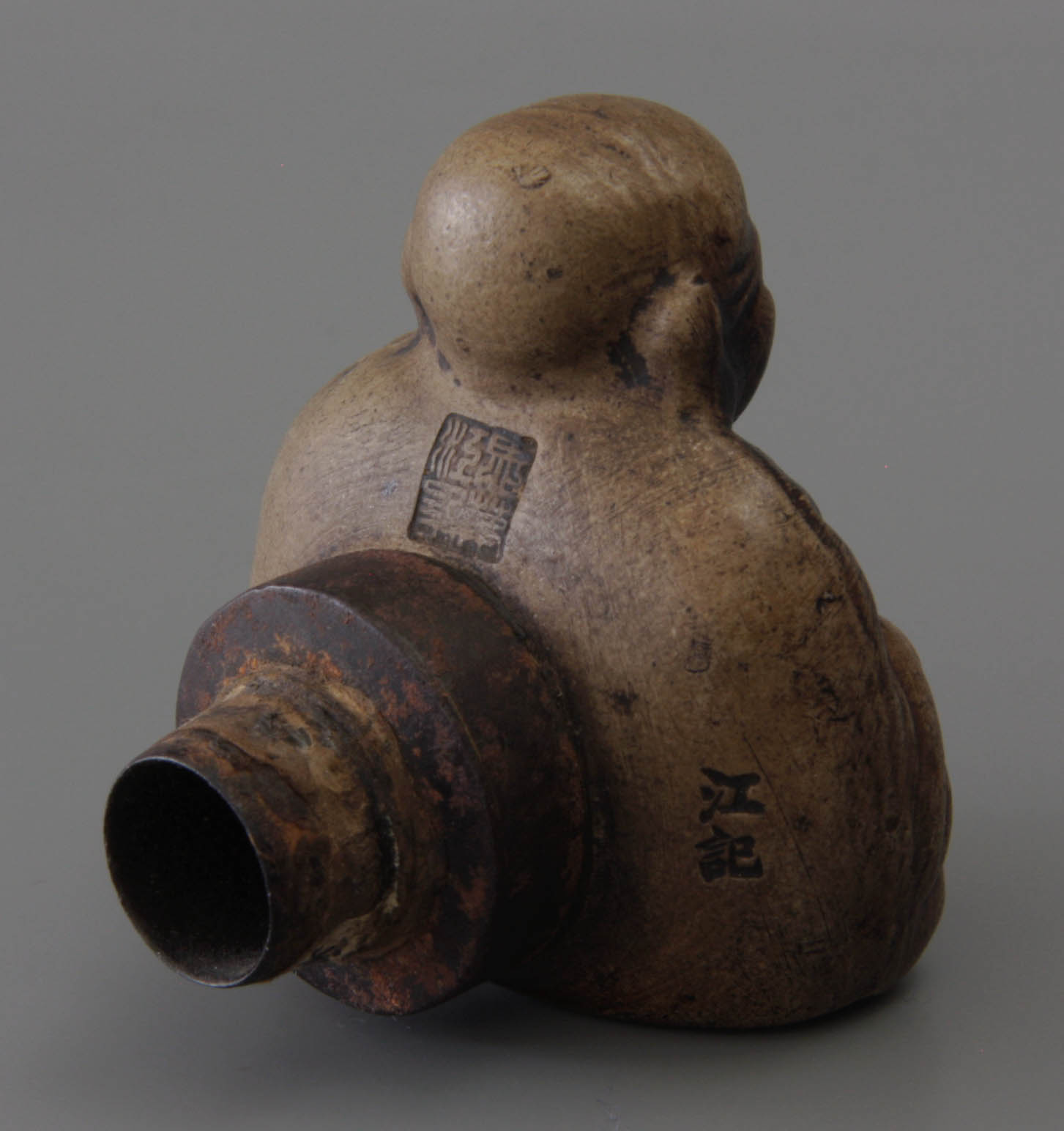
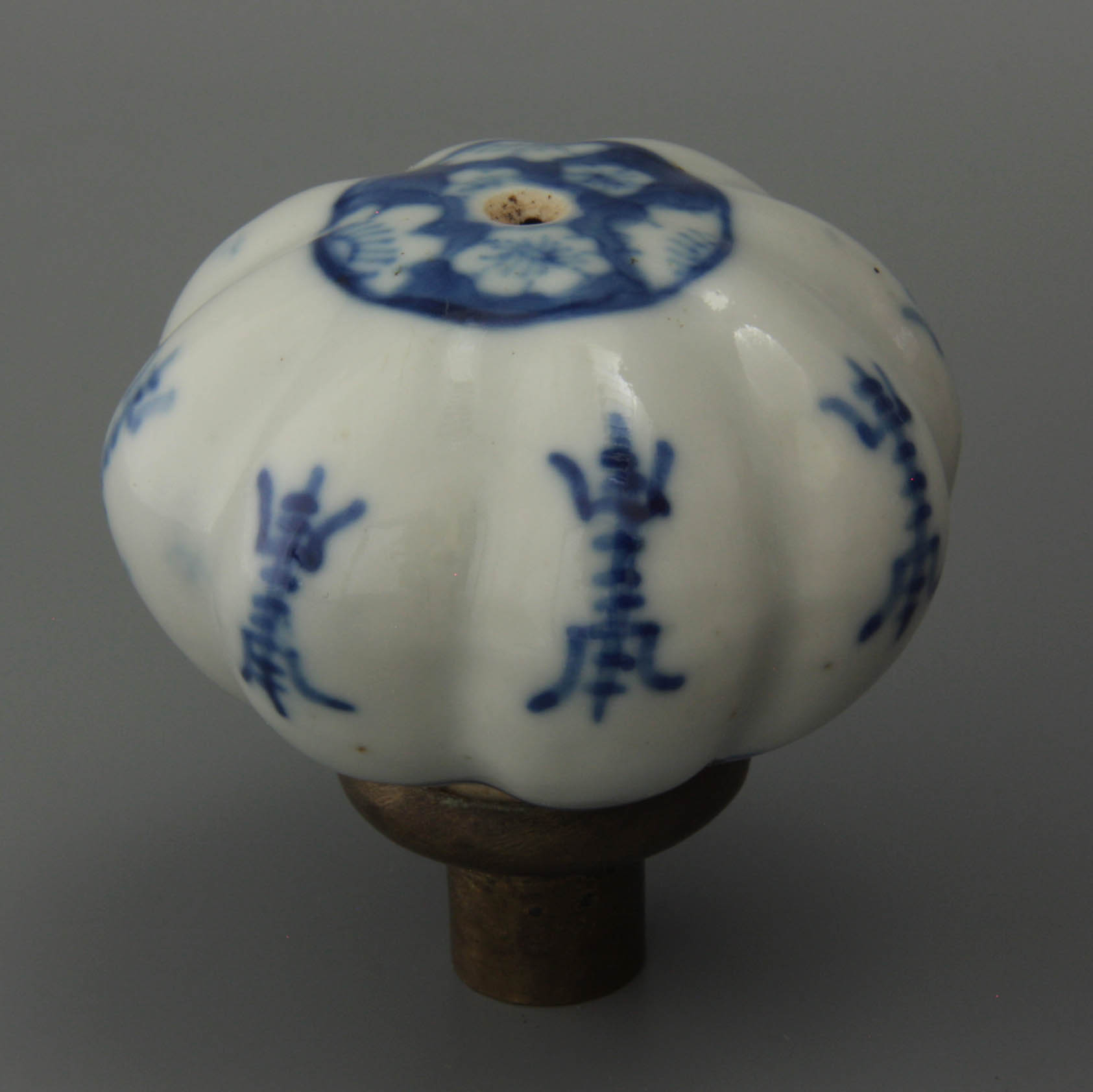

The most beautiful dampers show incised decorations filled in with contrasting colours of stoneware clay. They show representations from mythology, nature and daily life. Also calligraphy was often chosen. Sometimes a damper is executed in several colours of stoneware, a technique that we do not find with any other ceramic object. Of a more touristic nature, but sometimes surprisingly Chinese in terms of subject matter or execution, dampers are made in a figural shape. The depicted Buddha is a representative example of this style (Fig. 12). In addition there are, for example, a crab, lobster and twins. The relief was cast or printed in a mould. The finish is usually a bit less than with the smooth circular shapes; the polishing work has not been done so carefully so that seams of the mould joints remain partially visible.
Apart from red clay and stoneware, porcelain is used for opium dampers, but to a limited extent. Technically, for vaporizing opium this material is not so suitable. It has less mass which makes that the smoke does not cool down as well. Moreover, there is more risk in breaking due to uneven heating. An unmistakable advantage of porcelain is the possibility of painting. The damper shaped like a pumpkin shows porcelain painting characteristic for the nineteenth-century Chinese tradition (Fig. 13). The so-called soft-paste porcelain with the coarser, not entirely sintered shard is technically more suitable for opium dampers because with its heavier mass it provides better cooling. Nevertheless, this porcelain is only used for opium dampers in the last part of the nineteenth century. The shard is then covered with an rather indifferent colourless glaze so that they can easily be kept clean.
Finally, pipe bowls do occur in precious materials. On average, one in every hundred opium dampers is not made in ceramics, but from a type of stone. Jade is highly esteemed by the Chinese and is the most common of semi-precious stones. Because of the translucent quality of this type of stone an attractive transparent result can arise. Rarer, for example, is the use of the harder serpentine stone. In addition, opium dampers are made in metal, sometimes even with a decoration in cloisonné.
When assessing the opium pipes, it should be noted that dampers and stems were often stored separately. Smokers used multiple pipe bowls for a single stem, so that when they were smoking they always had a fresh, clean damper available. This means that the relationship between the damper and the pipe stem is less strict than one would expect. In principle, each stem can be equipped with every pipe bowl, provided the diameter corresponds more or less. However, a sense of form normalization will certainly have existed at the time. The thinnest stems combine badly with the largest dampers, as well as a stem with large thickness does not match with a small bowl. For the opium smoker there is a strong relation between bowl size and thickness of the stem and the effect the opium smoker aims to get when smoking opium.
Other paraphernalia
During smoking, the opium taker needs some other objects. First, that is the opium lamp for vaporizing the opium. Feature of the opium lamp is a reservoir covered with a high chimney-shaped lamp glass. This glass provides the draw in the lamp but also a stationary flame, necessary to heat up and vaporize the opium. In itself, the name opium lamp is strangely chosen, because it serves purely for heating and melting the opium so that the indication opium burner would be more appropriate. The lamp burns on oil and exists in many variations.
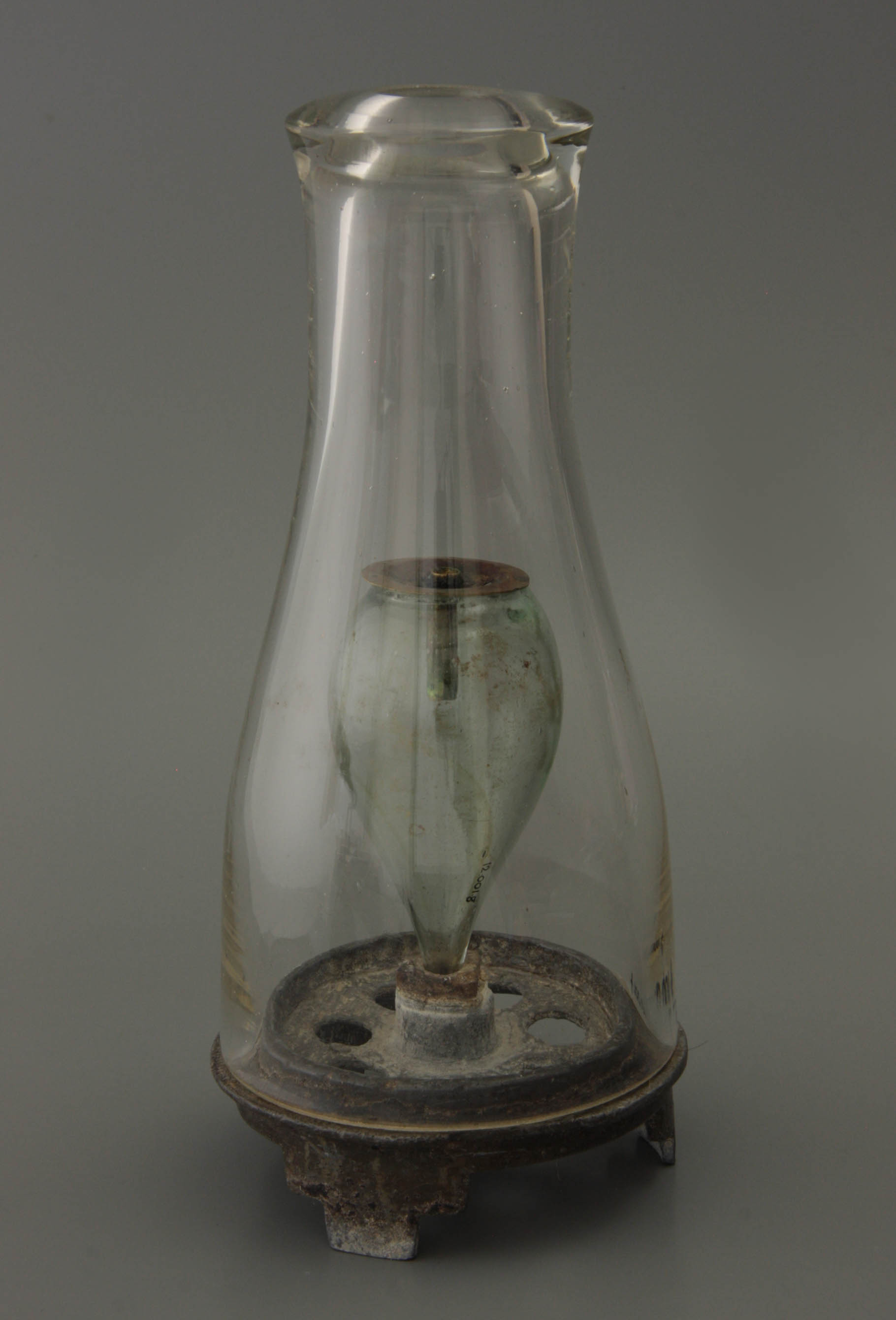
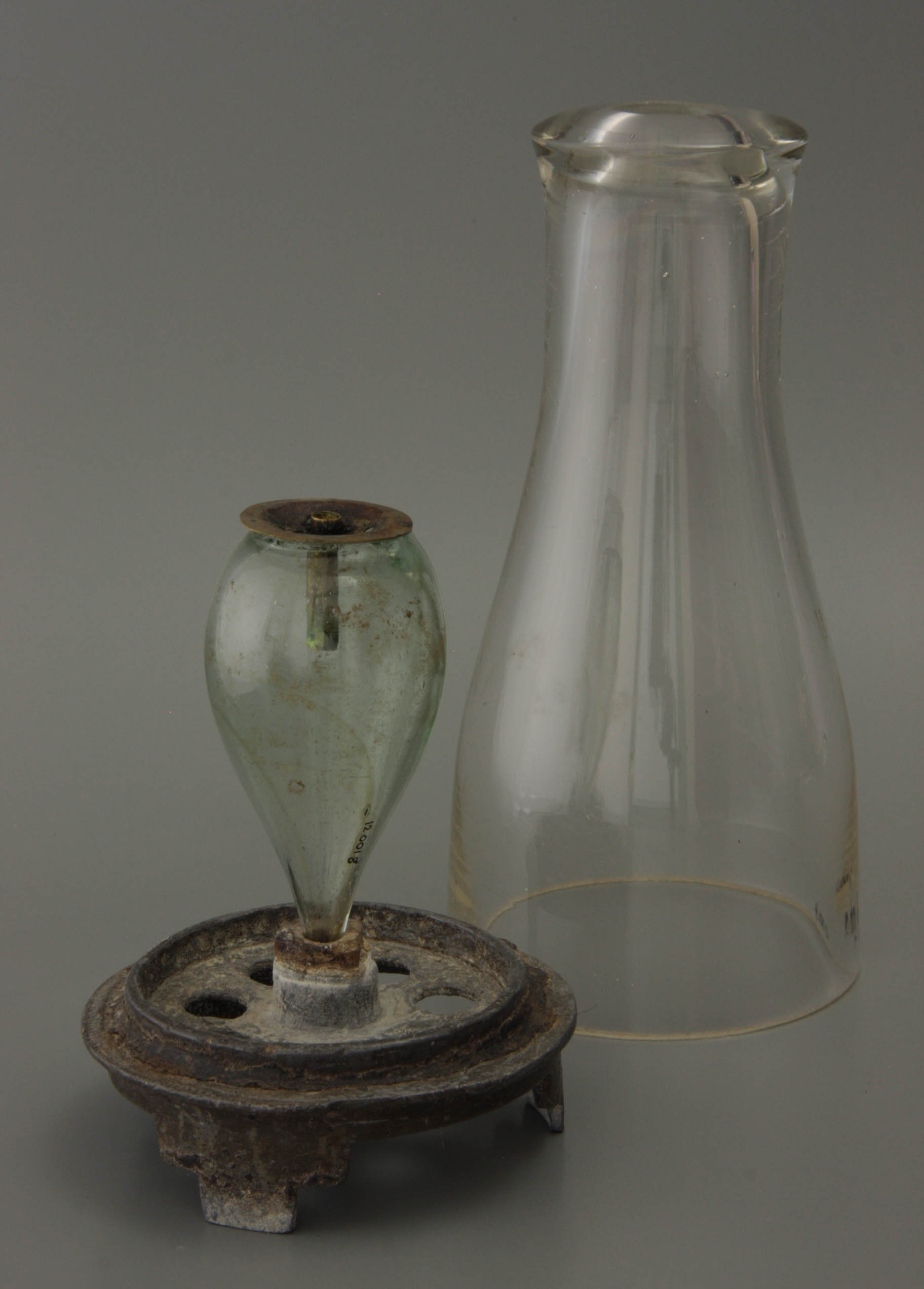
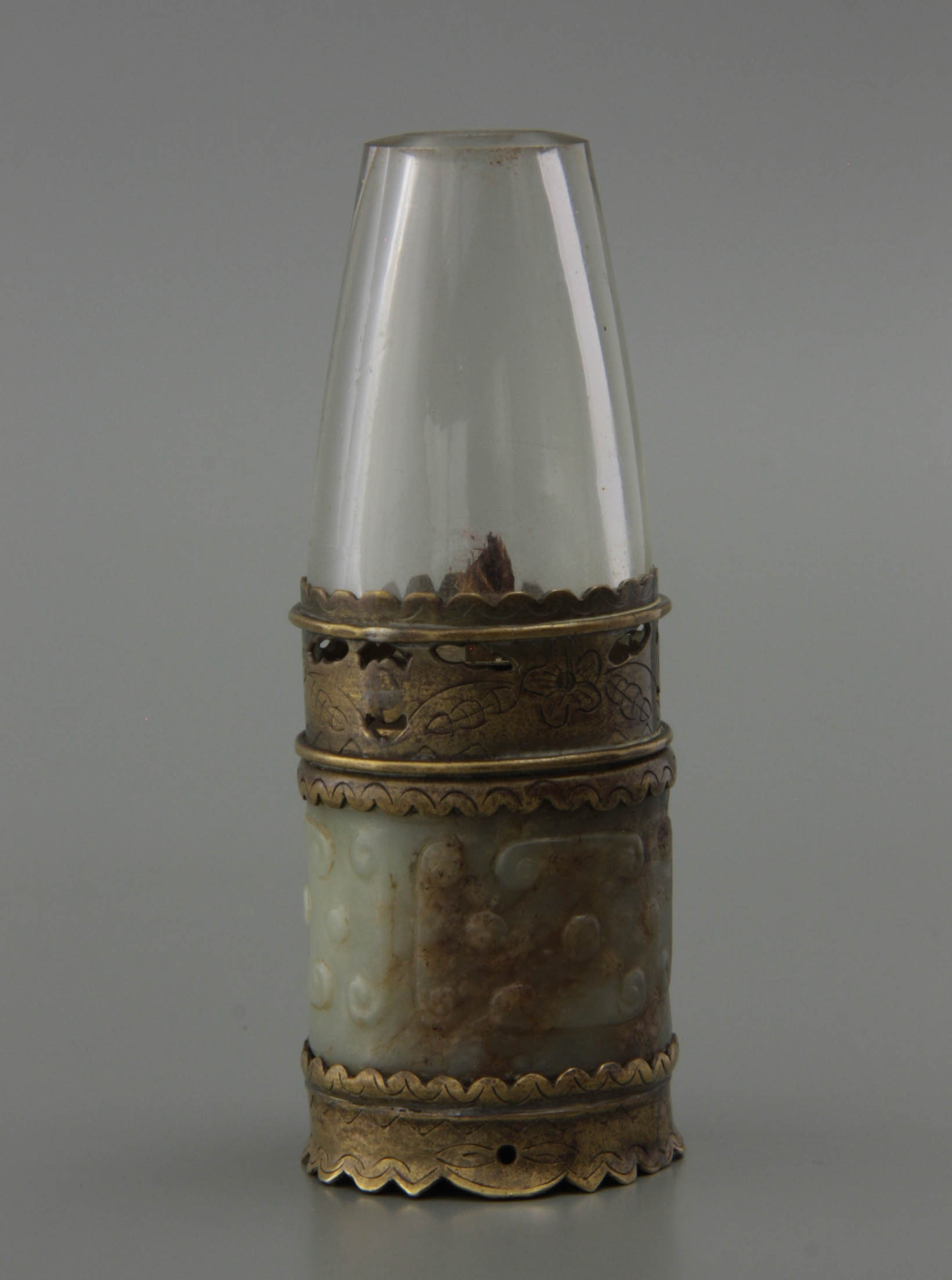
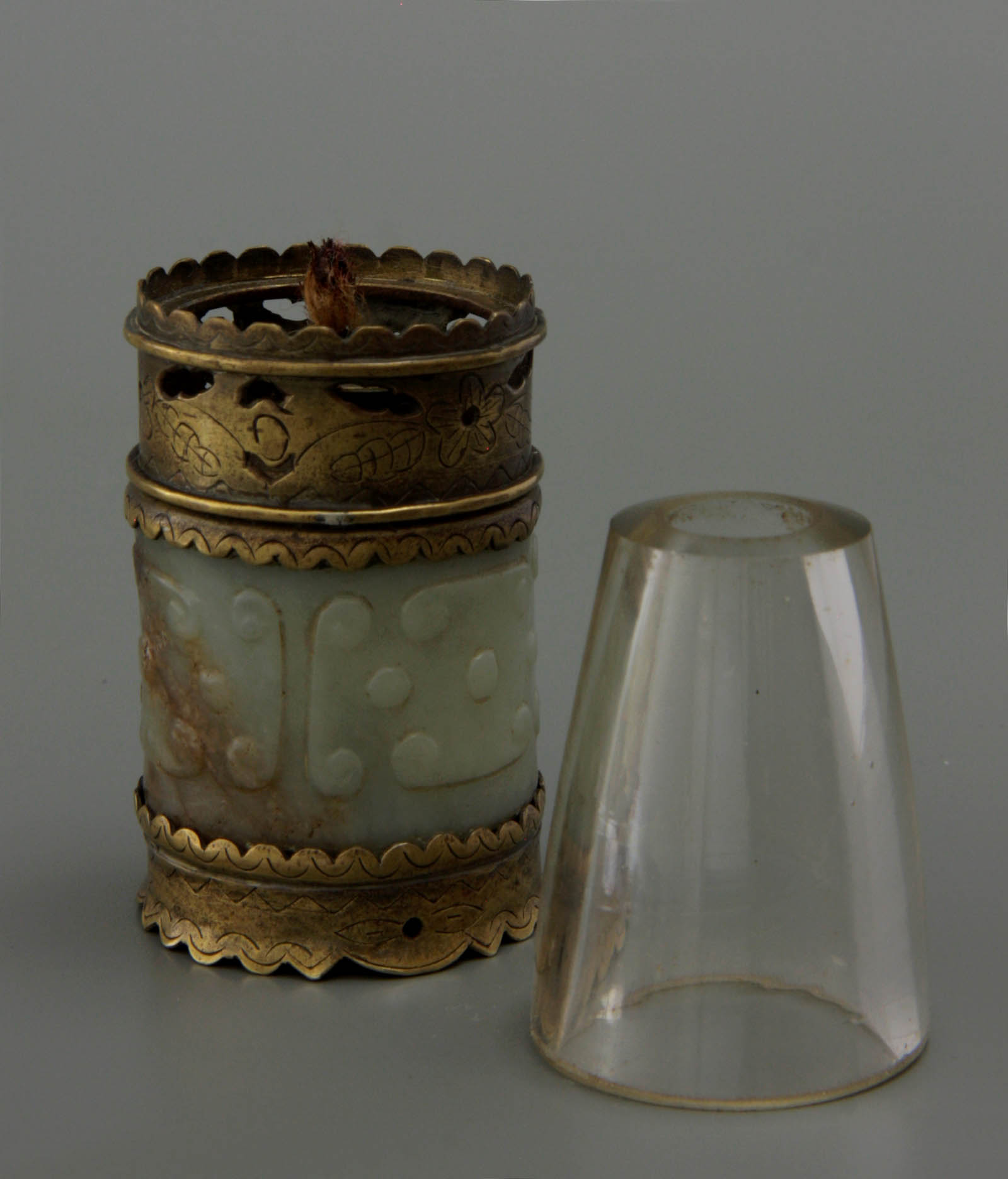
The poor man’s lamp is a simple burner with a lead foot, covered with a bell-shaped glass (Fig. 14). More expensive lamps are more luxurious and beautifully decorated. For example, silver opium lamps are known adorned with artistic embossment. Cloisonné on brass and carved jade occur. A remarkable opium lamp is made from an ancient Chinese archery ring of jade. The ring holds a brass oil reservoir on the top of which the lamp glass stands (Fig. 15).
In addition to the lamp, the opium needle is an indispensable attribute when taking opium. A small bullet of the fresh opium, which takes the form of a black tarlike substance, is placed on the sharp needle point of this instrument. Held over the glass of the opium lamp the opium is heated. Slowly melting in the heath the solid opium is likely to fall of the needle, when a second needle comes in to take over the opium bullet. In this way the viscous flowing opium is ‘knitted’ until one cannot hold it on the needles. Then the opium smoker places the needle with the ball of glowing opium in the small pipe bowl of the damper where the sharp needle tip ensures that the smoke hole is not blocked. There is a considerable variation in these needles, from the most humble, just an ordinary long needle with a sharp point, to the more luxurious. These are forged iron pins with a refined decoration on the handle and a scoop or spatula on the side opposite the needle.
Special equipment
The pipe, lamp and needle are the three most important objects for the opium taker. There is a wider selection of articles that are part of the same culture, but only in the more luxurious equipment. Depending on the status of the user and his or her lust for perfectionism, it runs from opium boxes, scrapers to clean the pipe bowl, to trays for presentation of the objects, bowl stands and even elongated cases for the complete accessories. A special item is the travel box, in which the entire garniture of the opium smoker can be stored. The unpractical long tubular pipe can be unscrewed in several parts in order to fit in the necessary.
The opium user's accessories can even go further. The most extensive set of smoker’s paraphernalia is exhibited in the opium museum at the three-border point of the Golden Triangle. This includes the headrest and even a complete bed. Remarkably, this set is executed in one and the same style and is made entirely of silver. Such equipment was intended for home use. In the opium kit the paraphernalia were less coordinated. The countless photographs of the opium dens from around the year 1900 usually show us a mix of predominantly shabby objects. As a luxury, only the traditional Chinese pipes stand out. Furthermore, the utensils are simple which is understandable for most of these opium kits were intended for addicts. They had lost their wealth due to long-term opium use, as a result of which their possessions had dropped to the minimum.
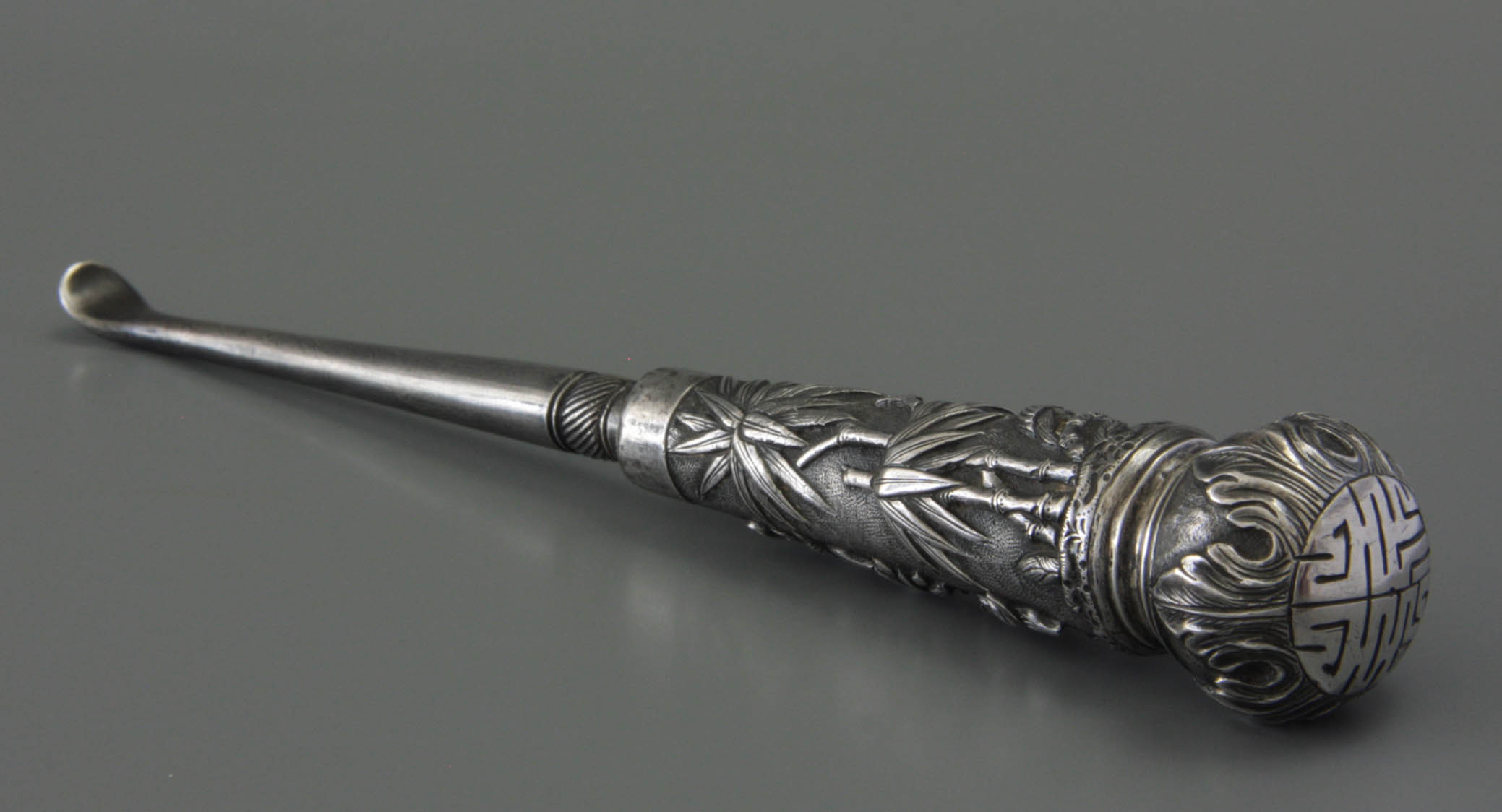
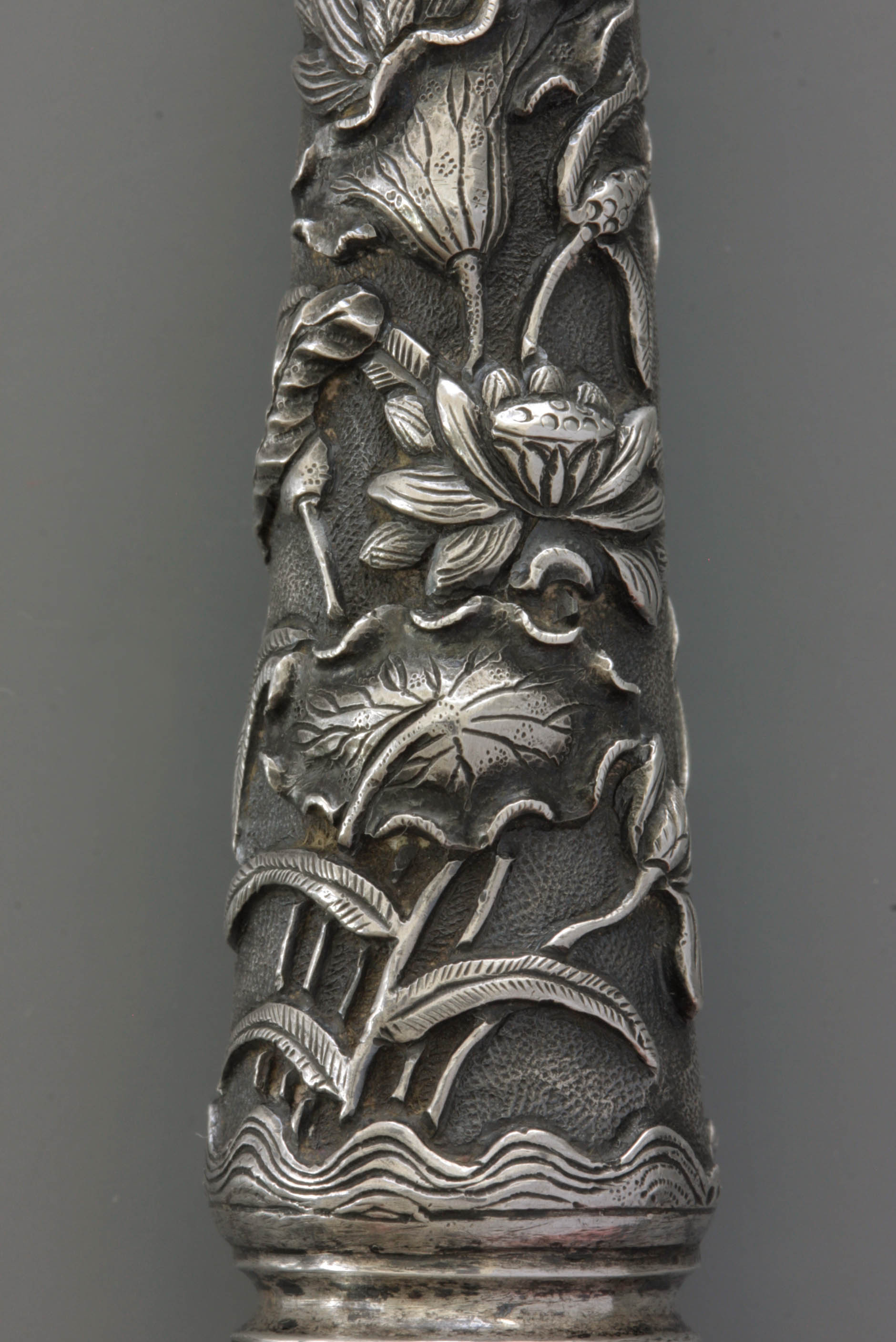
I would like to discuss two objects of artistic quality. Firstly, that is a special scraper to clean the interior of the damper (Fig. 16). This object has a fantastically embossed silver handle, in which nature is portrayed in the most idealized way. Noteworthy is the two-sidedness of this circular representation: on one side we see a bamboo decoration that changes almost unnoticed into chrysanthemums on the other side.
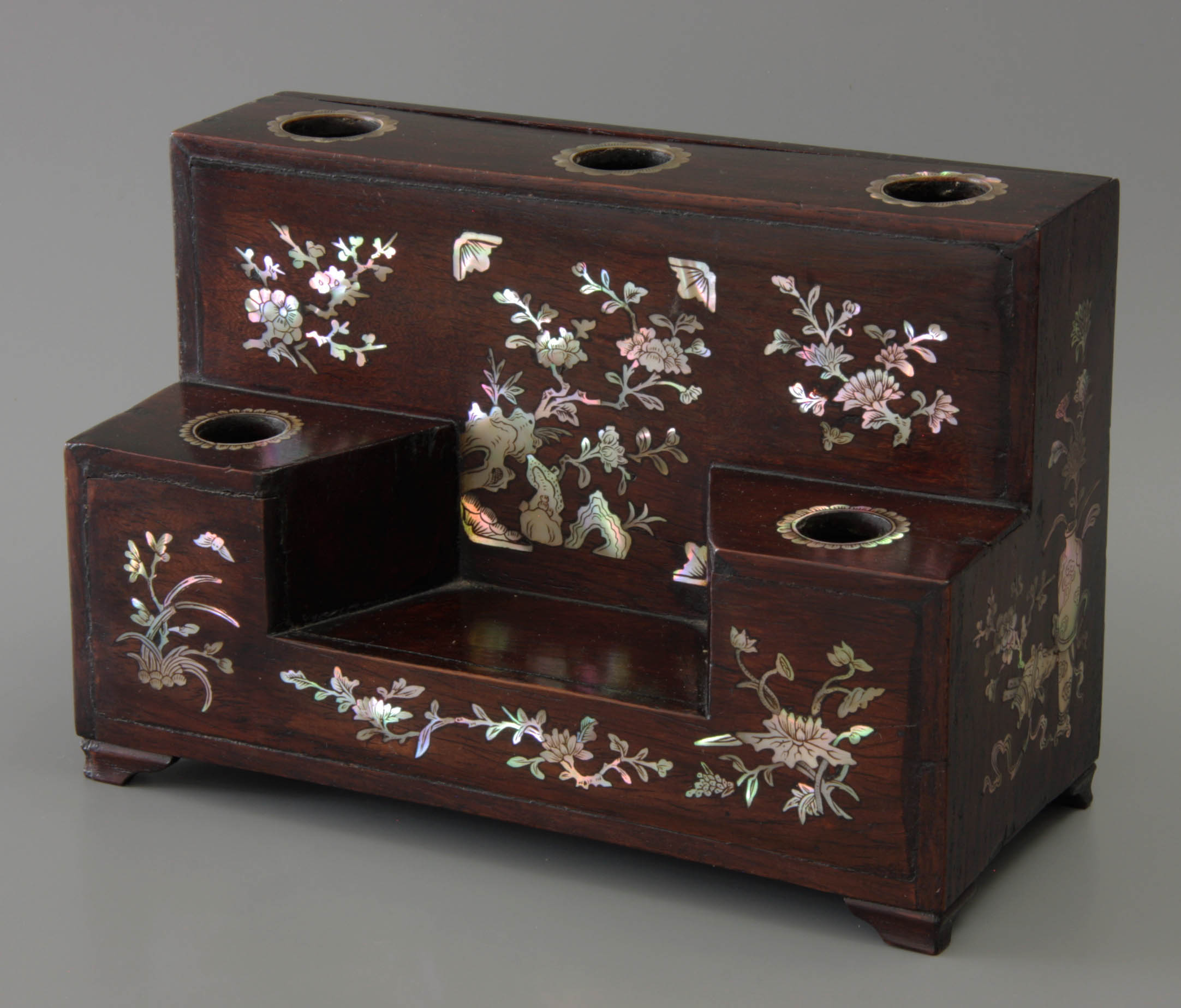

Another remarkable object in the collection of the Pijpenkabinet in Amsterdam is a stand for opium dampers that accommodates five bowls including an opium container (Fig. 17). This item is made of tropical hardwood and artfully inlaid with mother-of-pearl on the visible sides. The different surfaces represent all kinds of vegetative motifs. At the back this cabinet has a sliding door uncovering a hidden space where tools can be stored. Size, shape and decoration makes this a very rich stand. Simple stands for dampers have only a single level and accommodate three or four opium bowls. In addition to the wooden specimens, examples have been made of the previously mentioned Chinese white metal.
Surveying the series of opium paraphernalia it is obvious that the variety is enormous and that many objects have been made with great care, craftsmanship and artistic sense. Although form is always following the functional use of the object, in detail many variations have been devised. It is precisely these variations that makes it so interesting to build up a collection. Nearly all opium objects date from the nineteenth century. The material from the later period testifies to the repetition of what has already been done better. This is logical in itself, since there is no longer any positive annotation in the opium smoking after 1900.
Taking opium got a really negative reputation by the general public only during the Chinese Revolution of 1911 that ended the Chinese imperial dynasty. The initial mystical atmosphere and the possibility of escaping daily life in a pleasant manner became obsolete. Instead, the embarrassment of many families came under the burden of their addicted blood relatives. Particularly in the lower classes, opium use ruined millions of people. It is not surprising that with the turn of the Chinese government thousands of opium pipes in large bonfires have been burnt openly. That act symbolizes for the Chinese the end of an opium-dependent era. Because of the curse on the opium addiction and the major extermination actions, the opium pipe and the opium paraphernalia have become an objet de curiosité. From a status object for the user they were given a new position as an exotic and above all worthy collector's item for its interesting history.
© Don Duco, Pijpenkabinet Foundation, Amsterdam – the Netherlands, 1997.
Illustrations
- Two metal tobacco pipes as the earliest type of opium pipes to be smoked with a melange of tobacco soaked in opium water that is called madat. China, 1860-1900.
Amsterdam, Pijpenkabinet collections Pk 17.546 and Pk 17.547
- Opium pipe made from sugar cane with a simple white metal saddle and a red stone ware damper. China, 1890-1920.
Amsterdam, Pijpenkabinet collections Pk 12.002
- Opium pipe of bamboo with the disks of the bamboo flattened, the saddle in brass and copper with three semi-precious stones, bowl in red baking clay. China, 1880-1910.
Amsterdam, Pijpenkabinet collections Pk 15.043
- Opium pipe in ivory in three parts each part separated with an embossed silver band, the silver saddle with two Chinese persons in a landscape, bowl in Chinese stone ware. China, 1870-1900.
Amsterdam, Pijpenkabinet collections Pk 2.527
- Opium pipe in bone in five segments, the surface profusely decorated with an engraving, the lines filled in with black, the saddle of moulded lead, yi-xing pipe bowl. China, 1890-1920.
Amsterdam, Pijpenkabinet collections Pk 2.288
- Opium pipe built up in sections of turned buffalo horn, mounted with a silver saddle. China, 1870-1900.
Amsterdam, Pijpenkabinet collections Pk 14.588
- Opium pipe of bamboo covered with tortoiseshell and finished with a plain brass saddle the corners curved, completed with a black stoneware bowl. China, 1890-1910.
Amsterdam, Pijpenkabinet collections Pk 14.587
- Embossed silver saddle embellished with colourful enamel with the seven wise man standing on a cloud and the standing woman. China, 1895-1905.
Amsterdam, Pijpenkabinet collections Pk 12.726
- Opium pipe bowl in ceramic with incised decoration of bamboo and Chinese characters, a metal band round the bowl. China, 1880-1900.
Amsterdam, Pijpenkabinet collections Pk 13.471
- Beautiful opium pipe bowl glazed in four colours enamel, the so-called wu ts'ai. China, 1840-1860.
Amsterdam, Pijpenkabinet collections Pk 13.454
- Bottom view of a stone ware pipe bowl with stamped marks indicating the maker, the kiln, place of origin, sometimes also the date of production. China, 1880-1900.
Amsterdam, Pijpenkabinet collections Pk 12.741
- Pipe bowl in stone ware shaped as a sitting Buddha, casted in a two parted mould. China, 1880-1910.
Amsterdam, Pijpenkabinet collections Pk 14.739
- Opium pipe bowl in porcelain shaped as a pumpkin, decorated in the style of the porcelain painters of that period. China, 1870-1900.
Amsterdam, Pijpenkabinet collections Pk 12.702
- A poor man's lamp with lead base and a glass reservoir covered by a lamp glass. Vietnam, 1900-1920.
Amsterdam, Pijpenkabinet collections Pk 12.001f
- Exclusive opium lamp with a green jade ring mounted in brass. China, 1880-1900.
Amsterdam, Pijpenkabinet collections Pk 13.458
- Bowl scraper with embossed silver handle with bamboo and chrysantum decoration. China, 1900-1920.
Amsterdam, Pijpenkabinet collections Pk 2.856
- Bowl stand in tropical hardwood artfully inlayed with mother of pearl ornaments such as roses on a rock and flowers in a vase. China, 1880-1920.
Amsterdam, Pijpenkabinet collections Pk 12.750
Notes
- Jean Cocteau, Opium, dagboek van een ontwenning, De Woelrat, Amsterdam, 1986, p. 42. "We zouden moeten afrekenen met de legende van de opiumvisioenen. Opium doet een schemertoestand ontstaan. Het doet het bewustzijn inslapen, verrukt het hart en verlicht de geest".
- Benedict Goes, 25 eeuwen roken, de verwonderlijke wereld van de pijp, Leiden, 1993, p. 77.
Postscript
Read more about this subject in the magnificent monograph by Don Duco, Opium & opiumschuiven, Amsterdam, 2006.